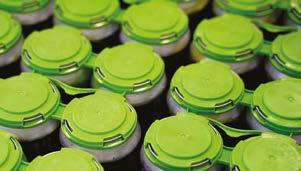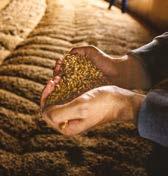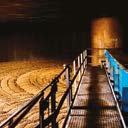








The Oxford English Dictionary defines ‘Authentic’ as: ‘Genuine; not feigned or false’. Trationally these are qualities that people respect and admire. But in an age of the social media deluge, coupled with the seemingly weekly release of new Artificial Intelligence (AI) apps and software, it is becoming more difficult to realise what’s real and what’s not. And in turn, it is becoming difficult to ascertain what’s genuine and what isn’t.
In the world of beer, knowing the difference between a genuine beer brand or one that is masquerading as such remains a pertinent issue. Many consumers won’t know the difference. Some, if we’re being totally honest, won’t care either.
But recent research released shows that almost a third (31%) of young beer drinkers surveyed now recognise the Indie Beer campaign, which has set out to promote beer from genuinely independent breweries and help people make an informed choice when purchasing a beer in pubs, bars or retailers.
And for many, operating in the increasingly competitive and saturated world of brewing, means being genuine and authentic has become more than just a desirable trait—it’s a necessity.
Those goals of staying true to yourself, building a positive working culture, creating a business people admire and also producing beers that consumers and your peers enjoy are traits any brewery owner strives for. And in a recent episode of very our Brewers Journal podcast, Alex Troncoso, the co-founder of Bristol’s Lost and Grounded Brewers ended the episode by outlining his team’s approach to the world of beer through the lens their flying hippo mascot.
“I was watching this documentary recently and it panned to some floodplains. There was a drone shot of some water and through that there was a path some hippos had made by walking through it. Once that path has been forged, other animals often follow,” he told us. “The hippos aren’t the rockstars of the animal kingdom but they’re determined and just get on with things without much fanfare. I like to think that’s a bit like what we do with our beers. We do our own thing and see where we end up.”
Breweries like Lost and Grounded have stuck to their guns and thrived as a result. That honesty is evident in their business and the beers they produce. The same can be said for Anspach & Hobday, the London-based brewery that graces the cover of this issue. Founded by Paul Anspach and Jack Hobday, the business has grown year-on-year with its nitro porter London Black leading the pack. And like their Bristol peers, chasing trends has never been the duo’s raison d’être.
“I feel that London Black emerges very naturally from everything we were doing before,” says Hobday. “Look at New England IPAs, for example. I don’t want to speak for everyone that has worked here previously but we collectively just don’t like them very much. There are, of course, great examples, but they are just not the beers that we want to produce.
I just don’t think the market would find it particularly believable coming from a brewery that’s never ventured into that territory previously.”
In a market where you need a unique selling point, proving yourself as genuine, authentic and believing in what you do is a great place to begin.
Tim Sheahan Editor
Dear John
Beer changes but why, and how? There are numerous reasons with some positive and some much less so, explains John Keeling.
Comment | Solar
How Healey’s in Cornwall expect to cut some £3m off its energy bills thanks to a new solar install.
Brewers Intelligence | Summer Reports
The latest insights and expertise from across the field of ingredients and sales.
RedWillow Brewery
Starting out in 2010, RedWillow Brewery has long since established itself as a leading light in the UK brewing industry.
Europe | Ghent
Ghent has gone on to become one of Paul Davies’ favourite places in Belgium. A regular visitor to this fine city, he explains how it’s the perfect showcase of both storied brewing heritage and also modern, forward-thinking brewers.
Containers and Distribution
Ensuring your brilliant beers reach the consumer in the way you intended requires high-quality packaging and distribution to match.
CO2 and Nitrogen
More breweries are investing in CO2 recovery systems and nitrogen generators as CO2 alternatives. But why should you take the plunge?
Homebrewing
Mike Clayton-Jones, co-founder of DoubleBarrelled brewery, shares a wealth of his formative experiences that have helped shape the muchloved Reading, Berkshire-based business.


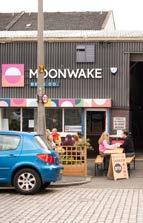
A week in my life
Miranda Hudson, co-founder of Duration Brewing, explains how she and the team help keep the revered Norfolkbusiness ticking.

17
Warminster Maltings
The team in south-west Wiltshire explain how they undertook a project of repair and restoration of Britain’s oldest working maltings.

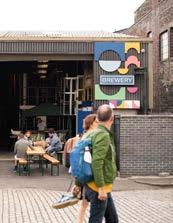
31
Vital Voices
A more open, inclusive and welcoming brewing sector isn’t just fairer, it’s more sustainable, and it’s better for all of us. With ‘Vital Voices’ we showcase and celebrate those working towards a better brewing industry.

Tim Sheahan Editor tim.sheahan@reby.media
+44 (0)1442 780 592
Tim O’Rourke Technical Editor
John Keeling Contributor
Josh Henderson Head of sales josh.henderson@reby.media +44 (0)1442 780 594
Jon Young Publisher jon.young@reby.media
Reby Media 6 Grove Road, Hemel Hempstead, Herts, HP1 1NG
The Brewers Journal is a published four times a year and mailed every March, June, September & December. Subscriptions can be purchased for four issues. Prices for single issue subscriptions or back issues can be obtained by emailing: subscribe@ reby.media
UK & IRELAND £45 INTERNATIONAL £69
The content of The Brewers Journal is subject to copyright. However, if you would like to obtain copies of an article for marketing purposes high-quality reprints can be supplied to your specification. Please contact the advertising team for full details of this service. The Brewers Journal is printed at Manson Group, St Albans, UK.
56
Anspach & Hobday
Through a commitment to drinkability and consistency, Anspach & Hobday has become a byword for quality in the capital.
All rights reserved. No part of this publication may be reproduced or transmitted in any form or by any means, electronic or mechanical, including photocopying, recording or any information storage or retrieval system, without the express prior written consent of the publisher. The Brewers Journal ISSN 2059-6650 is published bimonthly by Reby Media, 6 Grove Road, Hemel Hempstead, Hertfordshire, HP1 1NG. Subscription records are maintained at Reby Media, 6 Grove Road, Hemel Hempstead, Hertfordshire, HP1 1NG.
The Brewers Journal accepts no responsibility for the accuracy of statements or opinion given within the Journal that is not the expressly designated opinion of the Journal or its publishers. Those opinions expressed in areas other than editorial comment may not be taken as being the opinion of the Journal or its staff, and the aforementioned accept no responsibility or liability for actions that arise therefrom.

We work with brewers and distillers of all sizes to provide keg and cask rentals, container maintenance services and equipment finance solutions.
and others merging to survive, with pubs and hospitality venues continuing to hut for business and cease trading.
“Time and time again, the research shows that there is high demand for the innovative, interesting and tasty beers that indie brewers are best at making,” commented Andy Slee, SIBA CEO.
Demand for independent beer remains strong but UK brewers face “heavy headwinds” from increased taxation, market access restrictions and reduced alcohol consumption, according to a new report published earlier this month. While average production climbed 10% last year, nearly half (46%) of independent brewers say their main priority is survival and almost a third (29%) of these said they expect turnover to fall.
This is according to findings published by the Society of Independent Brewers and Associates (SIBA) which brings together industry insight and consumer polling to provide an authoritative report on the state of independent brewing in 2025. The SIBA Independent Beer Report 2025 shows that the average production of independent breweries last year climbed 10%, compared to an overall beer sector where national beer sales are down 1% since last year and now stand 6.6% below pre-pandemic levels.
For independent breweries the increasing popularity of porters, stouts, craft lagers and no and low alcohol beers helped drive growth.
But it’s not all good news for the indie beer sector, as at the same time the number of independent breweries fell by 5.5%, with around 100 closing their doors
“Our members are great at adapting to changing tastes and have increased the number of stouts, lagers and nolo beers on offer. Which has helped drive a double-digit growth in production amongst indie brewers. However, the current global trade anxiety and tax changes in the UK are making it a challenging market and indie brewers can’t get their foot in the door to get their beers to the customer.
“Our members currently have around 6% of the market and where they are allowed to compete against global breweries they could have 30% market share. This lack of access means beer drinkers are missing out, indie breweries are facing heavy headwinds to growth meaning fewer jobs are being created.” Slee added.
Andy Parker is the founder of Berkshirebased Elusive Brewing, which celebrates its ninth birthday this year. Commenting on the findings, he told us that it’s clear that the industry is still seeing some well established breweries fail in 2025 due to the hangovers of debt accrued during the Covid pandemic.
“Whilst they may be otherwise cash flow positive, the cost of servicing the debts is proving too much for some - especially those who are seeing aged debts called in without any room for further negotiation,” he explains. “Although the overall net number of breweries is down, we’re still seeing new openings and this must be seen as positive.
“Demand remains strong for local, independently produced beer and any new business would do well to focus on their local market as a priority, with a direct outlet such as a tap room being essential in today’s fluid and competitive market.”
Elsewhere in the report YouGov polling, commissioned exclusively by SIBA, shows that less than half (47%) of all consumers ever drinking beer and only nearly a quarter (28%) of 18-24 years.
More and more people are choosing not to drink alcohol at all, with 21% of all consumers increasing to 36% for 18-24 year olds.
The volatile trading environment had a cooling impact on the sector with 80% of breweries surveyed making no major investments in their business last year.
While breweries still intend to create more than 500 jobs this year, this is a significant drop from last years nearly 800 jobs.
The YouGov/SIBA figures show that beer drinkers are demanding a local product, with more than three quarters (77%) THERE ARE
Time and time again, research shows that there is high demand for the innovative, interesting and tasty beers,” Andy Slee, SIBA
And access to market continues to be the biggest issue for independent brewers.
saying it is important for pubs to offer a range of beers from local breweries. And 56% of beer drinkers say they would be more likely to choose a beer if it was locally produced.
Yet independent brewers report being unable to sell to on average 60% of the pubs local to their brewery. Eight in ten brewers surveyed said that it was the lack of access to beer lines as the top barrier to sales and growth. With average production amongst independent brewers increasing, it is stouts, lagers and no/low alcohol that is leading the way, with 24% on average now going into keg beers.
Eighty percent of brewers are now producing a stout or a porter with CGA data showing a 121% increase in ‘craft stout’ value in the on-trade last year. Lager has jumped to second place amongst brewers this year, with 60% now producing them, suggesting that independent breweries are now making some inroads into a market usually
dominated by global lager brands. With 14% of drinkers now opting for no/low products, independent brewers are increasing adding them to their range, with 15% now making a non-alcoholic beer compared to 8% last year.
From a personal perspective, Andy Parker reports that Elusive managed to grow in 2024 by reconfiguring our tank farm and leaning more on cask ale production where local demand is especially strong.
He told us: “Our output increased 26% by volume with revenue growing 10% amid a backdrop of increased costs due to taking on a 3rd unit to build a dedicated tap room.
“Although brewery numbers are down, we are still seeing new brewery openings and this must be seen as a positive,” Andy Parker, Elusive Brewing
“We’re still seeing strong demand but remain cautious operationally heading into the peak period of 2025, with the focus being on cost management, delivering positive cashflow and reinvesting rather than borrowing.
“Staffing costs have increased with the recent changes brought in by the budget but on the plus side, energy and ingredient costs are coming down and we’ve just secured a new electricity deal which brings with it a 30% decrease over what we were paying previously.”

Timothy Taylor & Co has appointed Emma Gilleland as the company’s new operations director.
Gilleland, whose role is effective from 15th September, will join from Carlsberg Marston’s Brewing Company where she is currently director of production. In her career she was also brewing director and at Marston’s, she was the director of brewing, director of supply chain and head brewer. She was also the first woman to be awarded the All-Party Parliamentary ‘Brewer of the Year’ in 2014.
Emma Gilleland said: “I am very excited to be joining the executive leadership team at Timothy Taylor’s as Operations Director. I am looking forward to leading the operational team to further build on the success of Landlord and the beer portfolio that is underpinned by the passion for exceptional quality.”
Holden’s Bottling has acquired South East Bottling’s (SEB) small packaging operations, marking a strategic expansion of its small pack capabilities.
The agreement sees SEB’s entire smallpack packaging volume transferred to Holden’s, further strengthening our position as a leading provider of highquality bottling and canning solutions.
Under the terms of the deal, Holden’s will take over SEB’s existing packaging business, ensuring a seamless transition for SEB’s customers while maintaining the high standards of service they have come to expect. SEB, meanwhile, will focus on its core brewing operations, allowing both businesses to thrive in their respective areas of expertise.
“This is a significant step forward for Holden’s as we continue to expand our small pack packaging capabilities,” said Mark Hammond, managing director of Holden’s Bottling.
Craft brewers produced 23.1 million barrels of beer in 2024, a 4.0% decrease from 2023, while craft beer’s market share by volume remained flat, new figures from the Brewers Association show.
According to the latest figures from its annual production report, the modern US craft brewing industry is one characterised as a maturing market in a rapidly evolving environment.
Employment in the craft brewing sector grew to 197,112 in 2024, a 3.0% increase over the previous year. The rise was driven by the shift toward hospitalityfocused models such as taprooms and brewpubs, which create more jobs in local communities, they said.
Craft beer’s retail dollar value rose to an estimated $28.9 billion, a 3% increase over the previous year. This growth reflects pricing adjustments and steady performance in onsite sales, which outpaced distributed sales in many markets. Craft beer accounted for 24.7% of the total beer market in terms of retail dollar sales.
In 2024, the number of operating U.S. craft breweries was 9,612, including 1,934 microbreweries, 3,389 brewpubs, 3,695 taproom breweries, and 266 regional craft breweries. 2024 was the first year since 2005 that the overall number of operating craft breweries declined nationwide. The total number of breweries in the U.S. dropped to 9,680, down from 9,747 in 2023. Over the year, 434 new breweries opened while 501 closed. Although openings declined for the fourth consecutive year—reflecting a maturing and highly competitive industry—the closure rate remained relatively low at approximately 5%.
Malting capacity at the UK’s largest malting site has increased further following the commissioning of a new
germination and kilning vessel (GKV) located at Simpsons Malt Limited’s Tweed Valley Maltings.
The new GKV, which became fully operational in late 2024, has increased annual malt production capacity by up to 15,000 tonnes per year, bringing total production capacity at the Berwickupon- Tweed site up to 260,000 tonnes per year – around 90% of which is destined for the distilling industry.
Groundwork on the GKV, which is where the second and third stages of the active malting process – germination and kilning – take place, started in May 2023 as part of a £10 million investment. It is the tenth GKV to be built at the company’s Tweed Valley Maltings, with the total capacity of the vessel being 400 tonnes per batch.
Malt produced in the new GKV – as well as the other nine GKVs on-site – has a significantly lower carbon footprint than the industry average, with energy for the kilning stage supplied by the site’s neighbouring Energy Centre.
Lallemand Brewing has launched LalBrew Aurora, a Saccharomyces cerevisiae targeted at various IPA styles, particularly the new Northern IPA style.
The first yeast introduced in this series, LalBrew Aurora was carefully selected from Lallemand’s extensive yeast culture collection for robust fermentation performance and unique aroma expression. With inspiration from the northern lights, LalBrew Aurora ferments well at lower temperatures to produce floral and fruity aroma that is exceptionally crisp and clean, the company said.
The company added in a statement: “LalBrew Aurora brings IPA in new directions by defining the Northern IPA style, which combines the clean drinkability of traditional West Coast IPAs with the modern yeast character of East Coast styles.”
Does each generation rediscover beer and then in doing so, reinvent it? Certainly, beer has changed over time but why does this happen?
Obviously, consumer demand influences beer choice. But with the advent of marketing, are consumers now being influenced to drink beers they perhaps wouldn’t normally drink?
When I first started drinking, way back in the 1970s, you could argue that there were two types of young drinker. One type were those who were influenced by their dads and as a result, drank his drink of choice. And on the other hand you had those who rebelled, did the opposite and wouldn’t drink what the old man drank. Indeed, the term ‘Old man’s drink’ has often been something a of a derogatory criticism of beers like cask bitter.
I was definitely a member of the former category, however, and loved - almost from day one of my drinking career - to enjoy a pint of cask beer.
I remember one time in my early stages of that drinking career (i.e. underage). I was out with a bunch of friends and we bumped into one of my friends’ dads in the pub.
Instead of throwing us out he bought us a pint each and this reminds me of how civilised and inter-generational pubs were in those days.
All of my friends were cask beer drinkers and generally would not drink lager. British lager in those days was weak (often less than 3.4% ABV), cold (sometimes an advantage) and fizzy (making it harder to drink for me).
If you look at the history of beer in Britain a number of beers have been popular for a period and then replaced.
It did have the advantage of being propped up by massive marketing campaigns. It was served from a keg and also paid less duty.
This made it very attractive to brewery owners and not so attractive to certain consumers (CAMRA) who recognised that they were being duped.
If you look at the history of beer in Britain a number of beers have been popular for a period and then replaced.
Porter and stout was replaced by mild, mild was then replaced by bitter and bitter found itself replaced by lager.
All those were popular for a reason. In my opinion they were good beers and they were also easy to drink, which

helped make them ideal for the pub environment. Only in the 1970s, following the change to the lager of the day, did breweries end up having the tools to influence the consumer.
The changes before the shift to lager were probably due to the improved brewing and malting technology available as well as fashion. And what is fashion but generational.
The reason beer did not change with each generation was there no alternative till a new style was enabled, and invented by the new technology available.
So, what happened in the 1970s? I think it was different then because the big companies wanted to change from cask to keg (for profit reasons through centralisation), from ale to lager (lower duty) and to produce national beers (again, a case of more profit). They used the tools that were afforded to them by marketing and advertising to help
push their agenda. Unfortunately, they generally succeeded in this.
Unfortunately for them too, with rising duty and VAT costs, increased competition forcing greater and greater marketing spend and a slow down in drinking (Who wants to drink pish? Could have been a great CAMRA slogan). They had to exist on wafer-thin margins and were then prone themselves to takeover
So, these clever people at Watneys, Allied, Whitbread, Courage and Scottish and Newcastle ruined beer for the drinker and in doing so ruined themselves. You could say it was poetic justice of a sort.
All I can say is thank God for the next consumer-inspired change in the form the craft beer revolution and also the increased availability of fantastic lagers, too. But let’s leave that particular story for another day.
Cheers!
The big brewing companies used the tools that were afforded them by marketing and advertising to help push their agenda.




WITH THE ADOPTION OF AI ACCELERATING THE DRINKS INDUSTRY IS POISED TO BENEFIT SIGNIFICANTLY FROM ITS EVERGROWING NUMBER OF APPLICATIONS. MOHIB RAHMANI, MANAGING PRINCIPAL AND HEAD OF THE DATA AND AI TEAM (IRIS) AT GLOBAL OPERATIONS TRANSFORMATION CONSULTANCY ARGON & CO, OUTLINES HOW THE DRINKS INDUSTRY CAN HARNESS AI AS WELL AS AVOID SOME OF THE COSTLY PITFALLS WHEN INCORPORATING IT INTO THEIR PROCESSES.
Artificial intelligence is not a one-size-fits-all solution; it comes in many flavours – and beverage manufacturers are no exception. In this industry, as in many others, the focus is on narrow AI –designed to excel at specific tasks like demand forecasting or quality control. For instance, machine learning algorithms can analyse sales patterns to predict demand spikes. Similarly, computer vision systems inspect packaging for defects at high speeds, improving quality assurance.
The real value lies in understanding where AI adds value and where human judgement remains irreplaceable. Take supply chain management, for example. AI can flag a delayed shipment based on real-time data, but a procurement expert is needed to interpret the context – perhaps considering the supplier’s reliability during peak demand, or thinking about alternative options. AI needs to empower people, not replace them.
Choosing the right model can save beverage manufacturers from problems emerging later down the line.
The first step is understanding whether your operations need narrow AI or general AI, which is capable of more flexible problem-solving.
Most beverage operations typically benefit from using narrow AI, using tools like supervised learning models for predictive maintenance or natural language processing for automating order inquiries.
Before selecting the right AI model, manufacturers should ask themselves: what is the goal? How clean is our data?
Is it scalable? Can the model evolve as our operations grow? Whatever the answers to these questions, will shape which AI model is most suitable for your business needs.
For instance, if you’re focusing on forecasting, forecasting algorithms work well; but for production, computer vision or anomaly detection tools might be a better fit for you.
Predicting changes in consumer demand is where AI comes into its own. Shortterm forecasting often uses time-series analysis, a type of machine learning that identifies patterns in historical data. For example, AI can predict a 20% increase in soft drink demand on a hot weekend. By using demand forecasting with external data, such as weather forecasts, school holidays, social trends, and macroeconomic indicators, both manufacturers and retailers can radically improve their short-term and long-term demand planning.
The supply chain areas that benefit most are those where there is an element of human intervention or decision-making where AI can be used to augment humans and remove the repetitive tasks, enabling them to focus on the more value-added activities.
An alternative example of this would be AI’s role in order processing, where natural language processing can read customer emails and automatically process bulk orders. Paired with soft process automation, this ensures orders are checked, validated, and routed faster than manual methods.
One common pitfall is choosing the wrong type of AI for the job. For instance, using rule-based AI for
demand forecasting often falls short because it can’t account for external variables like weather – where machine learning models excel. To avoid this, manufacturers need to carefully match the AI approach to the specific problem they’re addressing.
Manufacturers that adopt AI should not underestimate the importance of communicating with staff about how their AI tools work.
Staff must understand how their AI tools work for them to have trust and confidence in the predictions that inform their decision-making.
This may also involve the change management aspect of taking the organisation on the journey and highlighting the need for change.
For example, in the context of quality control over ingredients, a supervised learning model might predict outputs based on standard wheat properties, but it could fail when there is a slight
change in moisture levels. Manufacturers can address this by incorporating unsupervised anomaly detection into their systems to flag deviations in their raw materials, for features like moisture content.
Manufacturers inexperienced with using AI should start small. A prudent first step might be piloting a simple anomaly detection model for defect detection on a single product line, before scaling it up across all lines or using more complicated models.
There is a real opportunity for success in the case of supplier document intelligence. Here, natural language processing can extract key information from supplier agreements, certifications, and specifications, meaning the entire review process can be automated.
For example, natural language processing can identify allergens or sustainability claims hidden in complex documents, meaning compliance
obligations can be fulfilled without the need for manual checks. Natural language processing tools can also be used to continuously scan regulatory updates globally and map them to the company’s product portfolio, meaning businesses can stay ahead of the curve when it comes to observing their compliance obligations.
Another exciting development is recipe optimisation and ingredient matching. Machine learning models can analyse historical recipe performance, ingredient costs, and nutritional data to suggest optimal formulations.
2025 is shaping up to be a big year for AI in the drinks industry, as we see faster adoption of machine learning models, the promise of reduced waste, and healthier, more cost-effective options will soon be realised.










Everyone goes home safely to their family, every single day...
Protect your most important asset, your team. Stay connected with real-time updates and get audible and visual alerts of any gas, panic or motionless alarms including the rescue location and hazard type.
Your test and calibration certificates are automatically generated, filed and searchable...
Say goodbye to manual paperwork and hello to seamless, automated compliance. Save time, reduce errors and ensure you are audit ready.
You never run out of test and calibration gas again...
When your cylinders reach your pre-defined re-order limit, our software will ensure a restocking report is sent direct to your purchasing team. No stockouts. No downtime. No lost revenue.

Personal, Area and Fixed gas detection systems are all connected...
Our software transmits data from your Dräger personal, area and fixed gas detection systems straight to the web-based platform, offering true visibility of your site safety and helping to identify high risk hotspots.
We are by your side, 24/7.
With the 24/7 support helpline, you can rest assured we have your back, day and night.
Imagine no longer, get Dräger’s Gas Detection Connect. Contact Dräger today.
WARMINSTER MALTINGS, BRITAIN’S OLDEST WORKING MALTINGS, IS 170 YEARS OLD THIS YEAR (BUILT IN 1855). AS THE ONLY STAND-ALONE ‘FLOOR MALTINGS’ REMAINING IN THE UK, ITS SURVIVAL IS QUITE REMARKABLE. BUT HAVING ACHIEVED THIS, THE BUSINESS, THE ONLY MALTING COMPANY IN THE WESTERN HALF OF THE COUNTRY, IS NOW SET FAIR TO CONTINUE MAKING MALT FOR A LONG TIME TO COME. HERE COMPANY MANAGING DIRECTOR ROBIN APPEL EXPLAINS HOW THEY UNDERTOOK A BRILLIANT PROJECT OF REPAIR AND RESTORATION.
Following its acquisition by Robin Appel in 2001, repairs and restoration work began soon after. That the Grade 2 Listed malthouses were in such a poor state of repair could not be excused, but it could be explained. As a working maltings, the site had been on the condemned list for the previous 30 years but had always miraculously escaped. However, the introduction of Progressive Beer Duty in 2002 gave the business a whole new lease of life.
The arrival of a whole swathe of newbuild craft breweries brought with them a demand for malt products which exactly matched the Warminster business model. Individually, all orders were very modest – no more than 1 tonne per week, or per fortnight – but very precise: a range of different malts, malts that needed to be crushed, packed in 25kgs sacks, and delivered fresh ready for the mash tun. At the time, this was not a market that most of the UK malt capacity was geared up for.
This meant the Warminster business was quickly profitable, generating sufficient funds to start work on the buildings. This began at the front of the building, in the summer of 2003, creating new office space, and supporting facilities, along with space for visitors, mostly prospective customers, which had now become a frequent occurrence.
This first project turned out to be one of the most expensive, not least because the roof of kiln 1, immediately adjacent, but not part of the plan, chose to collapse at the same time. So that had to be rebuilt as well. You could say the 24 years long programme of works was punctuated by four major roofing projects, eleven separate roofs in all.
The second of these was in 2009, when all four roofs of the germination floors were stripped, enabling repairs to all the ‘A’ frames and rafters, which were all in a very poor state. Strict instructions from Historic England demanded that the original timbers, as much as possible, had to be retained. So, much bracing of new with old was required, in order to make the structures safe.
The third roofing project was what is termed as ‘The Old Store’, where the barley is stored above the steeping cisterns. This full width slate covered roof also included ‘The Sweater Kiln’ (for drying barley) immediately adjacent, a late Victorian ‘add on’ to the original complex. This project presented the opportunity to install 4×35 tonnes malt storage bins in the long redundant kiln, a hugely valuable addition to the somewhat cramped capacity.
At the same time as these major projects, involving outside contractors, much other work was also continually taking place, carried out by the Maltings’ own staff. This included all the windows which were fabricated on site, including restoring the wooden mullions, each exactly 4 inches apart, as laid down 200 years ago, by the strict regulations of The Malt Tax. Some of these windows also required replacement of the surrounding stoneware, and all those on the germination floors needed new hatches on the inside, courtesy of which the temperatures and humidity on the floors are controlled. And the list goes on.
However, the final roofing project has to be the most ambitious of them all. This is the restoration of the original pyramid style roofs to kilns 3 and 4, which were burnt down in a major fire in 1924. They were replaced then by ‘hipped’
roofs, with a flue running the full length of the apex. Planning permission from both Wiltshire County Council and Historic England was sought, and both agreed it was an exciting project, and permission was granted in 2018. But, unfortunately, Covid got in the way! So the work has only just been completed.
At the same time as all this structural work, all the engineering has been replaced or upgraded, and all the old electrics were stripped out and replaced with new. Then in 2017, a brand new ‘state of the art’ Weishapt gas fired kiln was installed. This has been a particularly
significant upgrade, both widening the spectrum of white malts produced, and combining the superiority of the ‘floor made’ modification with a very precise kilning capability.
Our maltings is our shop window, and it has always been our plan to present it in its best light. We do not want to be seen as a working museum, because we are quite definitely not that. We make malt the traditional way, and we want to show respect for that method.
We believe our malt is superior to “commercial malt” (a term the whisky

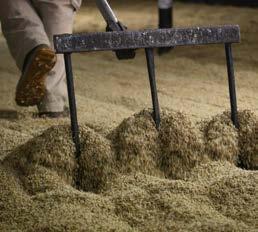
industry has conjured up for pneumatic malt), and our customers continually acknowledge that it is.
Not only that, we believe that the future of craft breweries does depend on maintaining the moral high ground through associations with desirable qualities such as local, artisanal, and sustainable. We are doing our best to deliver all this, and all the time we can, we are confident we have a robust and viable future. It is absolutely vital to maintaining everything that we have achieved so far, and to everything we look forward to achieving in the future.
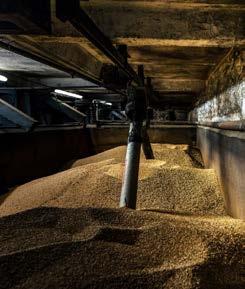

Healey’s Cyder Farm have been in operation since the 1980s when their first trees were planted.
As one of Cornwall’s very first independent brewers, they’re preparing their business for just as proud a future by working with CleanEarth Energy to install 1,224 solar PV panels at their site in Penhallow, Cornwall.
Healey’s have seen their energy bill triple in recent years, leading the business to reevaluate their energy mix.
Joe Healey, joint-managing explains: “The catalyst really was the energy spike. We wanted to maximise every square inch of every roof available.”
Their installation spans three rooftops and nine different roof aspects to get as much low-carbon low-cost electricity to their production line as possible –510,000kWh annually. This ambitious installation is going to take over £3m off their rising energy bill across the systems lifetime, savings that can be fed directly back into the business.
Price spikes in energy are unfortunately nothing new, and for breweries these kinds of growing costs can be difficult to navigate. Taxes, NIC contributions, tariffs, and the EPR fee are all pressures that will be felt by breweries wallets.
In light of the EPR regulation, recycling a glass bottle is now seven times more expensive than recycling a plastic bottle of the same size; making strategic decisions to mitigate overheads is increasingly crucial. But for Healey’s Cyder Farm and many other breweries, solar PV will have impacts even beyond these cost savings.
Recent reports have found that consumers are willing to spend more for sustainable beer options but are struggling to identify what these options even are. Though demand grows from consumers, brewers aren’t effectively communicating tangible sustainability efforts – a crucial gap between customer expectations and delivery from breweries. There’s also evidence to suggest that distributors and retailers are prioritising products with strong sustainability credentials.
Healey states: “It is very important to be demonstrating that we as a business take our environmental impact very seriously. It’s a fundamental part of our ability to sell our product to our customers”.
Renewable onsite generation is an easily evidenced step towards sustainability, that can not only power the energy intensive brewing process, but other innovations brewers may be putting in place for sustainability.
Last year, the UK’s independent brewing industry saw negative net closure rates every quarter, and by January 2025 the UK had seen a total loss of 100 independent breweries. The average closure rate was roughly 5.5%.
The industry is being squeezed, but despite the closures demand for independent breweries grew in 2024.
The potential is there, and breweries of any size or scale can incorporate cleaner electricity into their energy mix; grants open across the UK throughout the year that can offset varying amounts of the cost of solar.
At CleanEarth, a number of our clients in the brewing industry have benefited from this support, including Healey’s Cyder Farm, Lakedown Brewing Co, and Ludlow Brewing Co. The solar PV project at Healey’s Cyder Farm now means that roughly 40% of their onsite energy needs are met directly by their own renewable electricity.
Now in their second generation as a family-run business, Healey’s have reinforced their future resilience for the next generations. He concludes: “All of the decisions we make are with regards to the long-term future viability and sustainability of the business.”
And for many breweries in operation, this will mean embracing renewable onsite electricity generation.
All decisions we make are with regards to the long-term future,” Joe Healey. Healey’s Cyder Farm




BREWING HOPFORWARD NONALCOHOLIC BEERS DEMANDS NEW THINKING.
TRADITIONAL DRY HOPPING TECHNIQUES, DESIGNED FOR FULLSTRENGTH BREWING, FALL SHORT WHEN CONFRONTED WITH THE EXTRACTION, STABILITY, AND PROCESSING CHALLENGES OF <0.5% ABV PRODUCTION.
The non-alcoholic (NA) beer market (<0.5% ABV) is booming — but brewing truly hop-forward NA beers brings technical challenges that many brewers are only beginning to confront. Dry hopping, the cornerstone of modern aroma-driven beer styles, simply doesn’t behave the same way in lowalcohol environments. Without adapting their approach, brewers risk crafting beers that fall flat, lacking the vibrant hop character consumers expect.
Many hop oils, which contain the bulk of those aromatic compounds, rely on ethanol to dissolve and transfer into beer. Research shows that extraction of important hop volatiles dramatically decreases as alcohol levels drop. While terpene alcohols like linalool still extract relatively well even in NA beers, monoand sesquiterpenes — responsible for that “fresh hop” punch — struggle without alcohol’s solvent power.
Compounding this, fermentation in NA beer is often deliberately restricted. Less CO₂ evolution means less natural

convection inside the tank. Dry hops may not disperse fully, leading to poor contact and incomplete extraction. Brewers may attempt to compensate by increasing dry hopping rates, but beyond a certain point, adding more hops simply adds cost and raw material loss without delivering more aroma. Hop-derived enzymes introduce another layer of complication. Amylolytic enzymes can unlock residual fermentable sugars (hop creep), potentially triggering secondary fermentations and unwanted diacetyl formation — a defect that’s difficult to clean up with few active yeast cells left in suspension.
Meanwhile, esterases can erode the already limited yeast-derived fruity esters, dulling the overall flavor profile. Even when aroma molecules are liberated from hop vegetal matter, the majority of the hydrophobic terpene load binds to yeast cells and is therefore (unintentionally) removed during clarification steps. In short, traditional dry hopping — built for full-strength brewing — often fails to deliver the vibrant aroma brewers aim for in NA beer.
To evaluate real-world terpene loss at different production steps of the brewing process, Denmark-based EvodiaBio partnered up with Åben Brewery, analysing samples from a 20hL production trial of a 0.4% ABV hoppy IPA. The fate of key hop volatiles was tracked through the fermentation and clarification process using SPME-GC-MS (Solid Phase Microextraction coupled with Gas Chromatography–Mass Spectrometry).
Figure 1: SPME-GC-MS volatile analysis of beer in process
Cold side production consisted of crash cooling at target attenuation, dry hopping, 1-day hop maceration with rousing, clarification by centrifugation, dosing of Yops flavors (details below), short storage in brite, packaging, and pasteurization. Samples from three separate stages were evaluated. The analysis revealed a significant loss: compared to before centrifugation, concentrations of four major hop terpenes dropped dramatically in the after-centrifugation sample, with losses ranging from 6% to as much as 89% of volatiles (Figure 1). While clarification is critical for shelf-life stability, it may come at the cost of sensory quality. The Senior Brewer summed up his frustration: “In an ideal world I would not add any T90s to the beer because it’s a waste — they are all stripped.”
EvodiaBio developed Yops — a curated collection of hop-inspired, yeast-derived natural flavors — to offer brewers a
practical solution. Yops is specifically designed to replicate the critical aroma compounds typically contributed by dry hopping, focusing on key terpenes that bring beer to life.
In the trial, two Yops blends (FruityFR1 and Citrus-C1) were dosed directly into the beer stream immediately after centrifugation, as the beer transferred to the brite tank. Adding hop flavors after clarification avoids the risk of terpene loss to yeast adsorption. The results were dramatic. As shown in the bottom panel of Figure 1 (bottom-left of this spread), the terpene profile was not only restored but, in several cases, significantly surpassed the original dry-hopped benchmarks. Concentrations of certain terpenes exceeded their pre-centrifuge levels by over 300%, restoring the juicy, vibrant character that dry hopping alone could not achieve.
Process-wise, Yops dosing required minimal time and workflow disruption. Preparation and dosing took less than
45 minutes — a minor operational investment compared to the complexity and waste of additional dry hopping cycles. With no risk of secondary fermentation, no added material losses, and a bright, shelf-stable hop character, Yops delivered both sensory and process advantages. By reducing losses and maximizing aroma recovery, it helped to unlock the full potential of this NA beer. As interest in NA beer continues to grow, these kinds of adaptable, efficient tools will play an important role in helping brewers meet evolving consumer expectations — with flavor, consistency, and process control at the forefront.
Yops offers brewers a practical tool to help bridge the sensory gap, enabling the addition of key hop aroma compounds that could otherwise be lost. Yops can support the creation of bright, expressive NA beers all without adding process complexity or compromising stability, too.


BREWERS SHOULDN’T BE AFRAID TO TRY SOMETHING NEW. THESE TOOLS AREN’T HERE TO REPLACE TRADITION— THEY’RE HERE TO HELP YOU EXPLORE IT IN NEW WAYS, EXPLAINS CHARLIE GORHAM FROM CHARLES FARAM
If you have been following our news you’ll know that we’re working with Abstrax, a Californiabased flavour and aroma company, equipping brewers with tools to do more with less—less hop matter, less variability, and less waste. All without compromising on flavour or authenticity. They’ve even unleashed some unexpected sensory profiles.
Founded during the wave of cannabis legalisation in California, Abstrax didn’t set out to simply make THC products. Instead, its founders were captivated by the untapped potential of the intricate web of compounds responsible for the plant’s scent and flavour.
With few resources or existing extraction technologies available, the company had to build its expertise from the ground up. Abstrax’s national sales manager Craig Thomas said that they became the authority in cannabis aromatics and that it had started to snowball. They looked at other applications, and wondered what other solutions were out there - what else smells really good? What can we do with these aromas? And to that end, they have now also become the supplier for a number of different industries, too.
He said: “With the brewing industry in particular, we’re talking about water soluble flavours that go into beer, and really the one stop shop for creative expression, for efficiencies, for new economies of scale, and for finding different ways of making beer that resonate with people - and frankly it just makes sense.”
From that unconventional origin story came a suite of high-impact products now making waves in brewing, including the Quantum series of hop-derived, varietal-specific solutions, Skyfarm fruit-forward flavour top notes, and the BrewGas line, derived from cannabis terpene profiles.
Abstrax’s Skyfarm line has gained traction, particularly among breweries developing fruit- forward IPAs, smoothie sours, or low-ABV offerings where fresh fruit additions may not be viable due to cost, perishability, or also due to regulatory issues.
For award-winning head brewer Julian Shrago of Beachwood Brewing, the spark came not from a sales pitch, but from a pint of beer. Shrago spent over a decade as an aerospace engineer before pivoting to brewing and approaches his craft with a scientist’s curiosity.
He said that it was when he had a beer from Russian River Brewing in Northern California that he saw the potential of the Quantum Brite product made from selected hop varietals.
The beer was made with Russian River’s batch selected Nectaron hops. “I was like, okay, this is it. I immediately called Abstrax, and I said, let’s get this queued up with our select varietals right now. Late last year, we started making some permanent changes in both of our flagship beers, and that also led to us using Abstrax, Quantum, BrewGas, and
Skyfarm products in other beers that we were doing.
It really helped to dial in new flavour profiles or achieve traditional flavour profiles with less hop matter in the beer. It’s been something that’s worked out great. It is absolutely better brewing through science.”
Shrago also said that he understands people’s apprehension. “I think anytime you take something like brewing, which is seen as a very traditional, old-fashioned process and you introduce something that is very scientifically driven, there are people who might be like, well, hold on a second.
This isn’t how people make beer. However, it is absolutely a way to make things more consistent, perhaps make things better. It’s also a way to create new flavour and aroma profiles, and variety of beer that it has never been imagined before. I see it only opening new doors.”
“The UK is steeped in many, many centuries of brewing tradition. I think American consumers are used to new and ever evolving products. The UK has a slightly different consumer base, but I don’t see any reason why these products can’t be used to create traditional beers.
The benchmark for us with our flagship beers was, are the consumers going to notice the difference?
Nobody said anything and we did this months ago. I think a lot of the breweries here in the UK could fold these products in seamlessly, and the consumer would not know. And I think that’s, the true test of how successful you are”.
Luckily for us Abstrax don’t aim to replace hops, but rather to amplify and stabilise the flavours that brewers already love. For breweries dealing with annual hop lot variability, Abstrax offers the ability to lock in a specific crop’s aromatic
fingerprint and also to replicate it across future batches.
The claim is that if you get a standout lot of Mosaic or Nectaron, Abstrax can capture that exact profile through the Quantum technology and deliver it as a consistent input year-round, it’s like freeze-framing your best hops.
As hop prices fluctuate and consumer
you’re brewing on a one-barrel system or a fifty, Faram’s and Abstrax want to be part of that creative process for brewers of every size.
Beachwood Brewing is an independent, award-winning brewery crafting an innovative lineup of house beers, including distinctive West Coast-style IPAs, seasonal favorites, and limited releases. They started making beer at

“Margins are getting squeezed from every angle. If you can improve yield, reduce costs, and maintain quality, you have to do it,” Julian Shrago, Beachwood













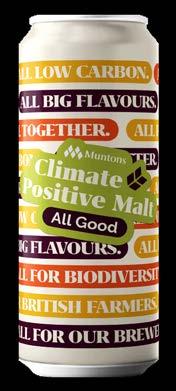
SUPPLY
OUR RELATIONSHIP WITH THE FARMERS AND OUR OLD FRIENDUK WEATHER - ARE ALL POINTS THAT ROBIN APPEL, THE DIRECTOR OF WARMINSTER MALTINGS , ARGUES WE MUST PAY CAREFUL HEED TO IN 2025 AND BEYOND.
Spring has been “bustin’ out all over!” to quote those famous words of Oscar Hammerstein. The sun came out in the third week of February, and in the South of England, at least, it has almost been wall-to-wall sunshine ever since.
Farmers were very quickly out in their fields, comfortably sowing all their Spring barley within the critical window of 15th February to 15th March. With no frosts to speak of, barley seedlings were soon poking their heads out after 7-8 days, and have been romping away ever since. What a contrast to last year when incessant rain delayed sowing until the end of April. The point is that this year our barley crops just might enjoy a full and timely growing cycle, and the chance to really optimize both yield and quality.
Now, at the time of writing, we are into May, and still “the sun has got his hat on”, and farmers have begun to get concerned. Farmers always pray for rains in May, the last ‘top up’ of moisture before the high summer sets in. I am less concerned. Over my 50 years or so of crop walking alongside farmers, it is
my observation that there is absolutely no substitute for sunshine. Provided the root system has it’s toes in moisture, photosynthesis drives plant metabolism from dawn to dusk, and within our barley crops, peak performance in this department optimises ear formation and the number of grain sites per ear.
Not only this, when it comes to cereal growing, sunshine is natures disinfectant. Most of the foliar diseases of barley crops are wet weather induced, and our Spring barleys have already outpaced some of their early and worst potential pathogens. Net Blotch and Rhyncosporium spatter their damage at the seedling to early stem extension growth stage, and our barleys are already striding past that, a spectrum of lush and green. So what could possibly go wrong? If we get no rain to speak of until mid to late June, grain size will be impaired, and even some grain sites abhorted. But probably the worst scenario would be the arrival of heavy rains as harvest begins. So let’s not speculate on either of these outcomes at this stage.
However, a bumper crop of barley this harvest is not necessarily going to be any sort of bonanza for farmers, I’m afraid. The malt market has quite definitely slowed down, both for brewing and distilling. And not just in this country. My agent in North America reports a downturn of between 15 and 20%. That’s huge! That is not quite my experience at Warminster Maltings, but our brewing customers are definitely not taking quite as much malt as they have been. We all know why, of course. So no maltster is going to be chasing barley markets this summer, or perhaps want to pay the sort of premiums that some farmers have come to expect.
But herein lies a potential problem another day. If farmers cannot earn a reasonable premium for malting barley,
they will simply cease to plant it. They do not have to grow barley. Even within their “regenerative farming” policy, which depends on crop rotations (and preferably a livestock enterprise), there is still a wide choice of other crops they can select.
Most ominous amongst these are the particularly lucrative contracts for maize, for biomass production. Farmers do not have to grow food! This is precisely why, for most of my career in the grain trade, I have been a strong advocate of properly managed supply chains. I am talking about both farmers and first processors in constructive dialogue to ensure continuity of production, both weathering the storms of oversupply, and protecting against shortfalls another year. Over time, maltsters, and flour millers, have always been keen on these initiatives, but mostly to incentivise the production of preferred varieties of barley, or wheat. Latterly, some maltsters have recognised the virtue of these schemes to protect overall supply. But, for the most part, brewers themselves are less engaged. Time for change I suggest.
I am not advocating that brewers should start talking to farmers, we would need to bring back the Corn Exchanges to facilitate that.
But I do think that brewers should double check that their maltster has a sustainable barley supply chain, one that is on message to farmers to do their very best to maintain both quantity and quality of the right varieties. And it is time for brewers to underwrite these arrangements, even if it means paying up for them.
Farmers are feeling overlooked at present. Their banners, strung up on field gates proclaiming “No Farmers, No Food!”, expresses their frustration. If we end up with pubs with no beer, we will all be joining in with their protest!
STYLES ARE SELLING WELL AT SOME OF THE UK’S FINEST BOTTLESHOPS AND WHAT WOULD THESE BUSINESSES LIKE TO SEE BREWERIES IMPROVE UPON, TOO? BREWERY MARKET, INDIEBEER, AND STIRCHLEY WINES & SPIRITS TELL ALL.
The changing drinks landscape is one that both breweries and their customers have to navigate in order to cater of changing consumer demands. And the UK’s bottleshops play an integral role in help accommodate and shape drinking habits.
And in Holloway, London, you’ll find one such establishment at indiebeer, a craft beer shop and tasting room founded by Clare and Owen Daniel. And when it comes to the styles and ABVs that are selling well in the capital, Owen says that as both a bottleshop and a bar, they’ve found there are two quite different answers to that question...
“When it comes to draught beer, there’s been a clear shift towards lower-ABV options. Customers—especially on Arsenal match days—are often in for a session and are specifically after beers around 4%, or even as low as 3.5%. Those lower-strength options are really important to that audience,” he explains. “But in the fridges—whether customers are drinking in or taking away—it’s a very different picture and we have seen a
polarisation in preferences.
“There are our core customers who are increasingly looking for bigger, fuller-flavoured beers. For around a year now, we have had an entire fridge dedicated to double IPAs, and split our IPA section in two so there’s now one fridge just for DIPAs, and another for sessionable and standard IPAs.”
He adds that imperial stouts are also selling well—driven partly by increased access to exciting US releases and some excellent barrel-aged offerings from Eastern European breweries.
“Then there are customers are who are searching for classic European beers, in particular alternative lager styles, such as Schwarzbier and Rotbier, and know that we are always adding new and exciting options in the lager fridge,” he says.
“So, in summary: on draught, it’s all about lower ABV; in cans, it’s a polarisation between full-flavour, higher strength styles like DIPAs and those seeking cleaner classic styles.”
And with this, Daniel says there been a shift in what your consumers are purchasing. “It’s an interesting dynamic, because it sometimes puts us at odds with what breweries are focusing on. For a range of reasons—including changes in taxation—many breweries are pushing lower-strength beers and are keen to sell more draught overall.
“But the irony is that while our draught customers are increasingly looking for lower-ABV options, and some customers are cutting out alcohol completely, the majority of our can-buying core customers are moving in the opposite direction. So yes, there’s been a marked change—breweries leaning one way, consumers pulling in another.”
Krishan Rajput is the proprietor of Birmingham’s Stirchley Wines & Spirits. In terms of market trends in the last 12
months, he’s seen a noticeable surge in the availability and retail sales of standard strength stouts due to the supply issues of Guinness in the latter part of 2024, And a particular standout for him was Anspach & Hobday’s London Black.
“The Low & No category continues to be a growth area for sales, whilst gluten free has stalled slightly (despite increased availability of styles and wider adoption within the industry). As always, local beers are still a prime influence with our customers in terms of sales,” he explains.
“The continuing popularity of Low & No is a trend that is very much in line with previous years; the popularity is driven partially by shifting drinking trends as well as more visibility of these products in social media circles (Ben Gibbs/ Soberboozersclub on Instagram being a prime example). Whereas we would probably view the increased interest in alternatives to Guinness as probably more of an anomaly.”
And in Twickenham, Linda Birch is the founder of Brewery Market. She echoes the views of Krishan Rajput adding that no and low-alcohol beers are continuing to gain traction. “We have increased the number of fridge spaces
“When it comes to draught beer, there has been a clear shift towards lowerABV options,” Owen Daniel, indiebeer
dedicated to this category, separated by style. Customers are seeking out flavourful options that suit a more mindful approach to drinking, and brewers have really stepped up their game here,” she tells us. “Also continuing from last year, one of the biggest sellers has been sparkling mead. It’s become a real talking point in the shop, it appeals to beer drinkers, wine drinkers, and the “not sure what I fancy” crowd alike. It’s that bridge beverage that invites curiosity.”
And what can breweries be doing more of and be doing better? “Packaging and delivery can still be a challenge— damaged cans from poor packaging or rushed couriers are all too common. Maybe there’s room for breweries in the same area to share a local driver?” asks Birch. “It could help cut waste, improve the cold chain, and even create jobs.
“We’d also really welcome more mixed packs and smaller MOQs tailored for independents. One thing that’s tough for small shops like ours is when breweries cancel events after we’ve placed a big order. We put a lot into sharing their stories—so a little more support for the little guys would go a long way.”
“Better transport packaging please,” adds Rajput. “And in terms of things that would be useful to us as a retailer, would be to see more breweries offer their beers in multiples of 12 rather than 24. That would give us more opportunity to take on beer with a reduced risk of getting “stuck” with stock, therefore more potential to restock with newer beers in a shorter time.”
At Indiebeer, Owen and Clare would love to see both breweries and consumers embrace a bit more style variety and experimentation. “It’s obviously a challenging time for everyone, with consumers wanting value for money and certainty when they make a purchase, and for breweries, and retailers, needing to be sure that the beer will be popular and sell quickly enough,” says Owen. “We’re currently stuck in a bit of a doomloop, which explains why we’re seeing so many customers gravitate towards DIPAs. It has become the ‘safe’ choice, and as a result, everyone’s sitting in that same hazy IPA space.
He adds: “We’ve seen a decline in classic European styles such as saisons, which is a shame, but we are also guilty of not pushing these enough. Those beers were a big part of what made craft beer exciting to begin with.
“And while I understand it’s risky, I really believe draft is still the best way to introduce people to new styles. But if you’re going to put something unusual— say a lemongrass or thyme saison—on draught, it shouldn’t be in a 30L keg. That’s a hard sell. Try and package it in a 10L keg instead.
“I know it costs more, and I know keg prices don’t scale with volume, but if we want variety on bars again, smaller formats might be the way forward.
“No venue wants a slower-selling beer to sit on the taps for weeks. It will look stale to the customers and also reflect badly on the brewery.”
And in working with a wealth of breweries Rajput highlights some names that have made an impression on him.
“The return to the industry of Burton Bridge/Heritage Brewing has been a very welcome sight this year. Burton Bridge was one of those breweries that we had stocked for a considerable amount of time up until the brewery was put up for sale,” he says.
“To see them return in such a vibrant way and with renewed vigour under the watchful eyes of Emma Cole and Al Wall is definitely something of note.
“It is one exampe that has shown us there is still a great deal of interest in traditional and heritage brewing.”
Rajput adds: We’ll also sing the praises for Elusive Brewing in Berkshire, who are fast-approaching their 9th year of operation and are still delivering excellent and approachable beers like Oregon Trail (their signature West Coast IPA) and their core red ale Level Up. As for newer breweries Rajput says that Scatterlings have caught the eye in the last 12-18 months.
The brewery is an offshoot mixed fermentation project from Brett Moore at Two Flints that focus primarily on saison style beers. Rajput says that one of their most recent releases ‘Green Hop, Green Bottle’ was “a genuine pleasure to drink”.
from poor packaging or rushed couriers are all too common,” Linda Birch, Brewery Market
At Brewery Market, Linda Birch says she wants to give a huge shout-out to Talking Tides Brew Co.
“I’ve been working with them for a little while and we’ve just secured a grant to scale up the kit and finally start canning ourselves. The brewery is fantastic— Steve McDonald is the brewer and the beers are consistently brilliant,” she says.
“Headland and Bark Side of the Moon really stand out for me. The new cans look great, the taproom’s got a brilliant vibe and top music, and they’re doing so much for the local area and community. They’ve worked incredibly hard to get to this point—they deserve more recognition. Their beers are currently available on Eebria, too!”
And for Clare and Owen at Indiebeer, both huge fans of West Coast IPAs, they’d understandably like to see more on the market. “We don’t think there are nearly enough of them these days, which is why we now have a dedicated West Coast section in both our IPA and pale ale fridges. It’s a style we’re keen to champion,” he says.
“Last year, we saw a wave of “modern” West Coasts, and slightly hazy versions, Bright IPAs and the like, that were all aiming to meet customers halfway. But I think there’s now a better understanding among drinkers of what a West Coast IPA is meant to be.”
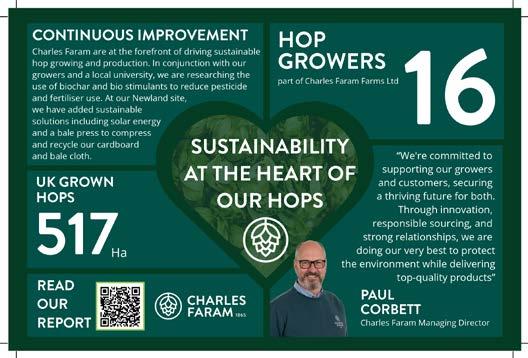

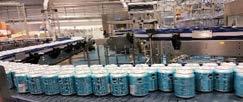

Tel : 01525 718288
E-mail : info@enterprisetondelli.co.uk
Website : www.enterprisetondelli.co.uk
• Want to take control?
• Want short production runs at your convenience?
• Want to reduce product losses at contract packers?
• Want to save transport costs and double handling?
• Want to reduce your carbon footprint?
• Want to control your own hygiene and QA procedures?
• Want improve your packaging?
• Want to save money on labour costs?
• Want to reduce your dissolved oxygen?
You can with an Enterprise Tondelli craft beer Canning, Bottling or Kegging line!
✓ 1,300 cans per hour upwards to 80,000 cph
✓ 1,200 bottles per hour upwards to 60,000 bph
✓ 16 kegs per hour upwards to 1,000 kegs per hour
When we started this publication back in 2015, two words we would hear time and time again were community and camaraderie. These were qualities that the beer industry, especially in a time of rapid growth thanks to the popularity of independent craft beer, boasted that it had in abundance. Why? Because it had them in abundance.
Knowledge sharing between brewers and the actual sharing of the tangible such as ingredients, production and warehouse spaces fed into the aphorism of “A rising tide lifts all boats”. Many breweries and the people behind them all bought into the idea of us being in this together and everyone wanted their neighbours and peers to succeed also.
Craft beer was a movement that helped showcase and shine the spotlight on the little and the large. And while much has changed in the make-up of this industry during the last 10 years, I feel that those qualities of community and camaraderie still exist today.
Granted, the beer industry is far from perfect but it has an awful lot going for it, too. In many instances, it has shown that anyone can potentially try their hand at being part of a brewing business, the broader indusry or even consider starting a brewery that can call their very own.
But as the beer industry has evolved and changed during the last few years, the
cultural and political fabric it operates as part of has transformed, too. In the US, President Donald Trump had barely begun his second sting in The White House when he started rolling back orders from the Biden administration. These included a directive aimed at preventing discrimination based on gender identity or sexual orientation with officials saying at the time that Trump would be “ending DEI” inside federal government.
We could use all 100 pages of this publication and of each edition that follow, and not even begin to scratch the surface of such implications when you consider that Diversity, Equity and Inclusion (DEI) encompasses people of different ages, races, ethnicities, abilities, disabilities, genders, religions, cultures and sexual orientations, and also people with diverse backgrounds, experiences, skills and expertise.
But what is certain is publications such as The Brewers Journal through its printed magazine, website, podcast and live events that take place across the UK can do its own small part to help showcase and platform the breweries, businesses and individuals within the drinks sectors that are showing how we can collectively do better and do more to help make beer a more inclusive environment for all.
In each issue we continue to recognise the vital voices this industry posseses, the action that they are taking and also the important work that they are carrying out in their businesses and beyond.
And from this year we will also celebrate and recognise these difference makers with the inaugural 'Diversity and Inclusivity Champion' award at our 2025 Brewers Choice Awards, which are taking place in London at The Big Penny Social this September.
Closing one of our previous events, the Brewers Congress back in 2021, Garrett Oliver, the brewmaster at Brooklyn Brewery and the founder of the Michael James Jackson Foundation for Brewing and Distilling (MJF). shared some powerful advice on the importance of getting “everybody in the room”. He told us that you should never assume that you know more than the person sitting in front of you. That we all should be more inclusive, and to have the courage to put ourselves in front of people who don’t look like us and maybe haven’t heard about the beer we make.
“There are a lot of people everywhere who would really like to discover what it is that we do. So you’ve got to bring in new people and they are going to hopefully be diverse. They’re going to hopefully be of all genders, they’re going to hopefully be of all orientations,” he said. “They’re going to hopefully be of all colours, if you want to have a great business and more importantly, if you want to have a really good time, then get everybody in the room. Not just some of the people, not the same people that you already know, but everybody."
Tim Sheahan Editor



IN HELPING START LEITH-BASED MOONWAKE BEER CO, THE BREWERY’S CO-FOUNDER VINNY ROSARIO WANTED TO CREATE A WELCOMING SPACE FOR ALL TO ENJOY. AND TO DO THAT, HE DREW ON SOME LIFE EXPERIENCES TO HELP GUIDE HIM AND THE TEAM ALONG THE WAY.
Afew years back, a friend of mine, a fellow brewer, and I decided to take his Dad, an avid beer fan, out to a few taprooms around London. His Dad had just recovered from a stroke and was still unsure on his feet/couldn’t walk for long. We were both excited to take him out on his first outing since recovering, but it didn’t last long. Neither the excitement, nor the outing.
We soon realised almost every taproom we went to had little to no accessibility for people with disabilities, and the few that did had no adequate toilet facilities. I was shocked and saddened. I also felt bad for never noticing this before. I had not had a lot of interactions when it came to drinking with people
with disabilities until this point and had taken for granted my mobility.
When I got the chance to help start Moonwake Beer Co, having a taproom was a key part of the dream. Ideally a mezzanine taproom overlooking the brewery. We were lucky enough to achieve this but it also came with one major snag.
Remembering the time walking around frustrated with no accessibility, I didn’t want this pain repeated for anyone else. So we installed a (very expensive) lift for anyone unable to use the stairs, open to everyone. We didn’t want a situation where someone had to get a key to
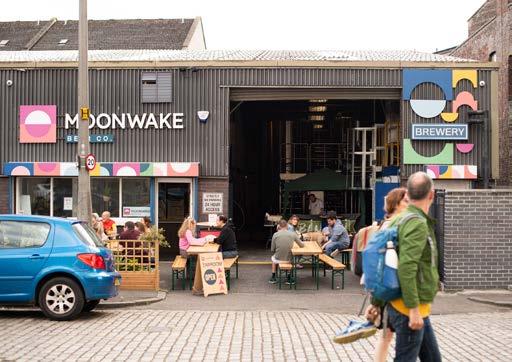
use it, because that’s the thing with accessibility, you never know how much someone is struggling with just a glance. I love hearing how people who use the lift enjoy coming to the taproom because they feel part of the experience, and can enjoy the view overlooking the brewkit. After all who doesn’t love staring at stainless steel?
For me unfortunately it took a personal experience to open my eyes. For too long minorities have had to impact someone personally to see change. This goes for people from all walks of life, not just physical disabilities. Though once you open your eyes, it is amazing how much there is to see and change. Granted a lot of this comes with life experience, but we can all learn from each other and pass on what we know. I have always wanted for Moonwake to be a welcoming place, that you can not only easily access, but feel happy to be there when you do.
We have gathered an eclectic team at Moonwake, with a vast array of backgrounds and experiences. It has been a genuine joy working with so many different people and everyone is employed on merit. There are always challenges leading a diverse group of people. Though this adds to the fun. You can learn from their experiences and
help shape a team that cares for more than just their own ‘in group’. It also leads to more ideas when designing beers. For instance, we recently released a saffron rice lager to coincide with Persian New Year.
I have always wanted to brew a rice lager, and working with my colleague in sales of Persian decent, she came up with idea of adding saffron and Basmati rice, aiming to pair it with Persian style food. A local Persian restaurant launched it for us alongside a specially designed tasting menu which formed part of their Persian New Year celebrations.
I am happy to say it was a grand success. Importantly it also pushed me out of my comfort zone to brew a beer I wouldn’t normally have done. And most of importantly it is now one of my favourite beer to drink.
We want this collaboration, respect and openness throughout what we do at Moonwake. Not just during the working hours or between certain individuals. From collaborating with Women in Beer and Glasladies to create a beer for IWCBD, right through to how our taproom staff interact with every individual that comes through our door.
This attitude does come from the top however, from both the company and the people in charge. It takes patience and understanding, but mainly it takes just looking at the world from outside your own personal perspective.
We all know how great craft beer is, and we should all be working together to strip down any and all of the barriers that we find to it,” Vinny Rosario, Moonwake Beer Co
It is also worth reaching out to some of the local groups in your area who would love to help.
But it has to start with the people in charge, and be implemented throughout. We have the power to make a difference together. Moreover we all know how great craft beers is, and we should all be working together to strip down any and all barriers we find to it.
Remembering the time walking around frustrated with no accessibility, I didn’t want this pain repeated for anyone else,” Vinny Rosario, Moonwake Beer Co
Once you notice the array of different people around you, you need to engage with them, be it taproom visitors or brewery assistants. They all have stories to tell, and deserve our respect. It can be scary going into the unknown, and frustrating when your views on life are challenged. Though remember, often people face great challenges every day and that many of these go unnoticed.
There are many initiatives out there to help you make a start if you do not know where to begin. Like the ‘Everyone’s Welcome Initiative’ by Melissa Cole, which we implement in our taproom.
A few years back, I was completely unaware how a couple of steps and a tiny bathroom could curtail somebody’s day out. It made me awkward and it also made me uncomfortable. I have now learnt it is OK to feel that way, in fact it is even good. Through this discomfort you can grow as a person, and discover new things. Next time I aim to try see the barriers before the impact me personally.
Moonwake is a modern Scottish brewery, established in 2021 by a team with extensive craft beer and brewing careers. The Leith-based brewery believe there is a beer out there for everyone.




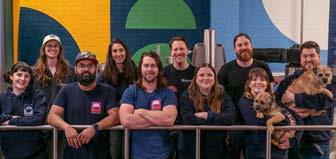


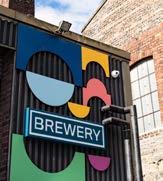













FOR PEOPLE WITH DISABILITIES, ACCESS TO A TOILET IS A MAKEOR-BREAK FACTOR WHEN DECIDING WHERE THEY GO; BE IT FOR WORK OR SOCIALISING, EVERYONE NEEDS TO PEE. JULIE SAWCHUK, AN ACCESSIBILITY STRATEGIST AND BEST-SELLING AUTHOR OF BUILDING BETTER BATHROOMS, EXPLAINS HOW WE CAN HELP ENSURE HOW BREWERIES AND TAPROOMS ARE MORE WELCOMING TO ALL.
If you can’t go pee you can’t drink beer. That’s a rather uncomfortable conversation starter, isn’t it? It’s biology — everyone (especially when drinking beer) has to empty their bladder. But what would you do, if after consuming a couple of pints, you realised that the WC was not available? You’d have a little panic and then you would seek out other options. BUT, what if there were no other options? No toilet that you could access. Cross your legs and have another beer? Not likely.
For people with disabilities, access to a toilet is a make-or-break factor when deciding where they go; be it for work or socialising, everyone needs to pee. For me, it’s the first thing I think about when planning an outing — where am I going that has a toilet that is accessible for me? What is special about me? I have a spinal cord injury that affects the way my body functions, including how I empty my bladder.
I literally arrange my day according to my need to pee; generally speaking, if I can’t use your toilet, you likely won’t ever meet me. What I eat and drink when I am away from home totally depends on the facilities that are available.
Have you ever considered that the toilets were the most important place in your establishment? If you don’t pay attention to how accessible they are, you are single-handedly excluding the world’s largest minority group, who (by the way) have money to spend.
The toilets? The most important place? Really? Look at it this way: what would you offer to do first? Would you help someone with a door to get into a
building or would you help someone within a toilet? You’d help with the door, right? Maybe it’s down a back alley and hard to find, or super heavy, or has an awkward handle that’s difficult to operate. Either way, you would help with the door. But the toilets?
You might go so far as to hold open a door for someone to get in, but that’s likely where your offer to help stops. The toilet is a personal space and society has taught us that no one is supposed to know or hear about what a person is doing behind that closed door.
Back in your establishment, you know you produce good beer. Your patrons enjoy themselves when they are drinking and eating at your establishment, right? guests are comfortable with nice stools at a bar, booths or chairs and tables, cozy lighting and great music. Everyone is welcome, right?
People with disabilities are the world’s largest minority community — are you considering the needs of all people?” Julie Sawchuck

Most people don’t even think about the toilets often; it’s just assumed that there is a toilet. But there are some things that you should make sure about that all-soimportant feature of your establishment. Is it: Easy to get to (i.e., no steps, steep ramps or sharp thresholds)?
Well signed (i.e., inclusive symbols, use of an arrow, easy to see from a distance)? Or is it equipped with a door that is easy to open (i.e., lightweight, free-swinging hinge or power operated)? Large enough for a person with a mobility device to get in with their device AND shut the door?
Well lit and quiet? Containing fixtures that make the toilet accessible (i.e., with appropriate grab bars)?
Ever since we (as a society) created indoor plumbing, what happens with our bodily waste has become a private activity, always happening behind a closed door. Sure, you know what you do in a toilet, but do you really know what
anyone else is doing, or how their body functions behind that door? We assume that we do because all bodies work more or less the same...right?
Not quite. You know what happens when we assume. And that is why we (as a society) have been getting it wrong (especially in “accessible” toilets) for such a very long time. Here is your opportunity to look at your toilets from a different vantage point and realise that accessibility is so much more than what is laid out by the “building code.”
People with disabilities are the world’s largest minority community — are you considering the needs of all people? First, vision loss. People who are blind or have low vision feel their way around a toilet — a room where no one wants to touch anything! This is why a simple layout, with no protruding objects and good colour contrast between walls, floors and features is so important. And
hand washing: a sink within reach of the soap and paper towels without having to “feel” or reach to find them? It really matters. How about hearing loss? Think safety. As we know, toilets are places for people to be alone. If you can’t hear that an emergency is taking place you need to be notified by sight. This is why having both audible and visual (strobe) fire alarms is needed in every space where someone could be alone.
Arms, hands and fingers function with strength and dexterity to do things like pulling the toilet paper out of the giant toilet roll, turning on the taps, pulling the paper towel out of the dispenser and opening the door. For some, asking fingers to get that next square of toilet tissue or turn and slide a lock might actually be an impossible task.
Access to hooks, shelves and waste disposals goes a long way to helping people while they are seated on the toilet; appropriate placement of such features will also help your WC stay neat and clean. We also need to understand that all bodies are different. Creating gender-neutral spaces for people to choose which toilets they find most comfortable allows people to feel safe.
These are just a few of the “uncomfortable conversations” that we, as a society, have not been having about accessible toilet design. Everybody goes, especially those who drink beer. I’ve pulled grab bars off walls and even been trapped in toilets with such heavy doors that I had to wait for someone else to come along.
Once bitten, twice shy certainly applies here — knowing that I might run into a difficult situation might mean I do not show up at all. So yes, getting everyone into your building is just the beginning — being able to stay when they have to go — isn’t that more important?
Julie Sawchuk is an accessibility strategist and the best-selling author of Building Better Bathrooms — Get the help you need to make your space more accessible at www.juliesawchuk.ca.




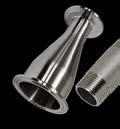

AN OVERNIGHT SUCCESS 11 YEARS IN THE MAKING, ANSPACH & HOBDAY HAVE LONG SINCE CEMENTED THEIR PLACE IN LONDON’S RICH BREWING FABRIC. THROUGH A COMMITMENT TO CLASSIC AND HERITAGE STYLES, COUPLED WITH A FOCUS ON DRINKABILITY AND CONSISTENCY, THE BREWERY HAS BECOME A BYWORD FOR QUALITY IN THE CAPITAL AND BEYOND.
Sometimes it can take an awful long time to really find the one thing that pulls it all together.
“Everything prior to London Black has essentially been the groundwork for the one beer that has given the business a real, true identity and also the hope of a sustainable future,” says Paul Anspach. “I suppose you could say that this beer is kind of a distillation of what we were building from the beginning.”
The liquid in question is London Black, Anspach & Hobday’s flagship beer. A 4.4% nitro porter, it’s a beer that had long been in the hearts and minds of brewery founders Jack Hobday and Paul Anspach. But its one that, through the pandemic lockdown, and the associated disruption to daily lives and routines, that enabled the duo to research how best to transform and specify their session porter for nitro dispense and can package.
The end result is a beer that brings together the rich history and heritage of London Porters with the modern techniques of brewing nitro beers, London Black is characterful, yet smooth, balanced and effortlessly drinkable. Notes of coffee and chocolate are balanced by red fruit from the hops, and brought together with the creamy mouthfeel by the use of nitrogen.
Jack Hobday adds: “The success of that beer doesn’t mean we take it for granted. I feel that after the last decade or so, the big lesson of business is that just because you’ve made something you think is of real quality doesn’t mean it all simply works out in your favour. “There’s a lot of learning, finding your way and working really damn hard. I guess that’s the sort of dream of youth meets the practical reality of brewing for some 11 years. Some things work, others don’t.”
Friends since meeting in nursery, Paul Anspach and Jack Hobday founded their eponymously-named brewery in Bermondsey back in 2013. A part of the capital that has seen breweries both come and go, Hobday is acutely aware of his brewery’s established position on that famed stretch.
“Back when I was working in Brixton at the Craft Beer Co, I’d always be suggesting to our customers that they must visit breweries such as Partizan, The Kernel and Brew By Numbers,” he recalls. “So to then start your own brewery in the same area and find that the beers you were producing were being recognised in a favourable manner alongside businesses and people you have so much respect for meant a lot. It gave us that encouragement and also it fed into our ambition.”
And that ambition was underpinned by a desire, like many great brewers, to make the beers that they want to drink and also the hope that the consumer will come along that journey with them.
Over the years this has resulted in the production of beers such as ‘The Rauchbier’, ‘The Pale Ale’ and ‘The London ESB’ to ‘The Imperial Baltic Porter’, ‘The Pfeffernüsse Stout’ and ‘Sea Salt & Lime Gose’.
Chasing trends has never been the duo’s raison d’être. “I feel that London Black emerges very naturally from everything we were doing before,” says Hobday. “Look at New England IPAs, for example. I don’t want to speak for everyone that has worked here previously but we collectively just don’t like them very much. “There are, of course, great examples, but they are just not the beers that we want to produce. Don’t get me wrong, we have had conversations about making them because commercially there might be a really sound business

If we can still be here in 5-10 years contributing to London’s brewing scene then that’s amazing,” Paul Anspach, Anspach &
Hobday
case for it. But I just don’t think the market would find it particularly believable coming from a brewery that’s never ventured into that territory previously.” He adds: “Whereas with a beer like London Black we feel that it does all kind of make sense and it’s more of a believable style for us to be making and drinking.”
In addition to London Black, visitors to the brewery’s ever-popular Arch House in Bermondsey can enjoy beers such as the ‘Smoked Brown’, ‘The Porter’, and ‘Bermondsey Pale Ale’, to the ‘Ansbacher Lager’ and ‘Ordinary Bitter Smooth’. Beers that remain testament to the styles the team continue to enjoy making, drinking and selling.
“Jack has always been more of a historian than me but I think it’s maybe the fact that we learned a lot about beer and its history when we were initially learning how to actually make beer that it all really resonated,” says Paul Anspach.
“It’s hard not to learn about what came before and not be inspired and enthused by it. For us the history of beer and our enjoyment of making beer are somewhat wedged together.”
Hobday adds: “For me, it’s a bit like science or music. You are standing on the shoulders of giants of those who have come before you. That gives you a direction regarding what others have done before. We are not so ‘anoraky’ that every beer has to be from a recipe we have found in someone’s attic but at the same time, why not riff on that or at least have a look at it?.
“There is something humbling in having the awareness to go back and look at how things were done. Not least because you will often find surprises. For example I can’t imagine many would expect us to feature American hops in our London Black recipe but historically the import of hops from America was quite a big thing. Or that our Ordinary Bitter features corn in the grain bill, which is again very traditional but not something that everyone would expect either.”
Anpach & Hobday beers are produced on the team’s 40HL brewhouse that
operates out of its production facility in Croydon alongside six 80HL FVs and a quartet of 40HL and 60HL vessels. There is potential to double, or even treble, production capacity but the duo admit that with such a move would likely come the need for an additional unit, too.
“We have a bunch of tanks for single brews and some for double brews, with London Black going through on that side,” says Hobday. “So maybe a new unit might have to come into the equation.”
London Black accounts for approximately 450,000-500,000 litres of production per annum while the rest of the capacity is primarily accounted for by its Bermondsey Pale Ale, The Ordinary Bitter, Ansbacher Lager and the brewery’s special releases. While London Black dominates much of the spotlight, Ansbacher Lager and The Ordinary Bitter continue to swell in popularity, too.
At 5.0% the lager is a bright, brilliant gold in colour, and is clean, crisp and refreshing. It has a delicate aroma of traditional and contemporary hops is paired with a subtly sweet malt base. While the 3.4% Ordinary Bitter is brewed with US Chinook hops and boasts delicate hop aromas of pine and dark fruits followed by a smooth, velvety palate, with notes of biscuit and caramel. The Ansbacher Lager is typically
lagered for 30 days but never sent to package unless its ready. “Tank capacity is obviously a premium when it comes to beers like lagers so you find yourself inclined to put them into a bigger tank but then you also find that you’re moving into London Black territory. It’s a balancing act,” explains Anspach.
Hobday adds: “There’s definitely some tension in that respect because we want to carry on making really great lager. It doesn’t sit well with us if you’re planning on cutting corners when it comes to lagering and we’re seeing more and more accounts considering taking it on as their main lager in addition to London Black. It’s an unusual situation to be in where we’ve inverted it and the lager or pale is an add-on beer to the porter rather than the other way around!”
Keeping everyone happy and all products in growth are all-too familiar growing pains for many breweries but it’s also a challenge the brewery is facing head-on. And with London Black at the helm, they know they are in a great position to push on, too.
There is something humbling in having the awareness to look at how things were done before you,” Jack Hobday, Anspach & Hobday
“At one point in time porters produced in London were the biggest beer in the world in terms of volume and this year, there’s a good chance we will overtake Fuller’s as the largest porter producer in London,” says Anspach. “It’s at a much smaller level than the Victorians had it but still, it’s quite a step for a small brewery like ours. The way the dark beer market is growing, why can’t we start to bring back some of those historical volumes?”
While the volumes of London Black produced at Anspach & Hobday continue to grow, the team acknowledge they are “minute” compared to the production volumes that emerge from Guinness at St. James’s Gate brewery in Dublin. But the frequent comparisons with the famed Irish liquid are something that spur on the brewery. “We have not tried to clone Guinness. But there was obviously a gap in the market for a local Londonproduced alternative to it,” says Hobday. “It filters back to that respect for the past and what came before. There are
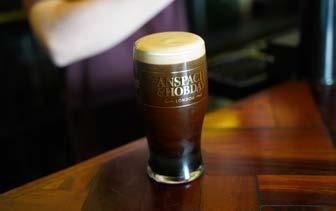

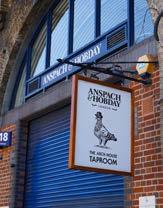
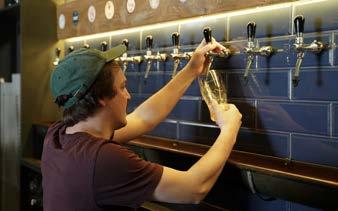

so many lessons to learn from such a business. And if you are entering the market as the smallest David to the biggest Goliath and think you are simply going to take them out then that is quite simply mad.”
He adds: “What we respect and learn from Guinness is the importance of a clarity of message, a singularity and a focus on what you do.
“There are obviously some aesthetic cues that we flirt with but I hope that enough of our originality comes across so it’s clear that we’re actually coming up with something new and interesting.”
And the beer that was once called the ‘Nitro Porter’ and then ‘London Dark’ before becoming ‘London Black’ is proving just that. As a company Anspach & Hobday has experienced year-on-year growth of approximately 24% but over the last six-to-nine months that’s tracking at closer to 50% thanks to the success of their beloved porter.
That beer continues to attract a growing legion of fans and among those ranks is Jason Hackett. A bridge expert who has won titles across the globe, he’s also a beer and food reviewer.
The content creator and social media star, known as Prime Mutton, has nearly 150,000 followers on Instagram and has clocked up millions of views on YouTube.
A beer fan and one that has a real penchant for a quality pint of Guinness Hackett’s passion would eventually lead him to try London Black and such is his love for the brewery’s beer, he can be often be found stopping in at the Anspach & Hobday Arch House when following his beloved Manchester City F.C. in or around the capital. or while in London for his travels.
Hackett tells us that Anspach and Hobday are “pioneers” in modern craft brewing. “To the point that their London Black has become more than a craft beer,” he says. “It is the British nitro porter. In fact when served on 80/20 gas at their taproom in Bermondsey, it’s the best stout or porter you can get in Britain.”
“He’s a very, very honest man,” adds
Anspach. “When he says something, he means it and he’s genuine. It’s amazing the attention his work has garnered for us and we sincerely thank him for that.”
Through breweries such as Anspach & Hobday, dark beers are well-and-truly back in the spotlight and the appetite is there for all to see. In the same way that excellent outfits such as Lost and Grounded Brewers, Pillars, Braybrooke, Donzoko, Braybrooke and others have shown that the modern consumer demands and wants a great UK lager
“I think our feeling is that with London Black, especially when we already were well established on the Bermondsey Beer Mile, has played its own small part in making our Arch House something of a destination,” says Hobday.
“We are selling much more than we were doing in previous years and while the dark beer market is in growth I think we are probably experiencing growth levels beyond that. So of course we are going to use that environment to lean into the provenance and story of the beer.”
The branding and storytelling surrounding London Black, which includes the artwork and glassware has already helped the brewery win a number of design and branding awards with associations such as SIBA and also at our own Brewers Choice Awards. So it’s only natural that the team choose to showcase this in Bermondsey.
“If you’re interested in the world of beer then our Arch House has become a spot that people will visit specifically to try that beer and thankfully also the others we make too. And often they will bring others along with them and as a result, we get new fans of London Black, our beers and of our brewery. And for that we are very grateful,” he adds.
The momentum and success of that beer has been so great that when the London outfit moved to their new production facility in back in 2020, London Black had yet to exist. So for a brewery nearly 12 years into its story, it’s also one that is just getting started, too. “I was at a beer
London Black has become more than a craft beer. It is the British nitro porter,” Jason Hackett aka
festival earlier this year and someone asked me if I worked for ‘London Black’,” smiles Anspach.
“But to be known as the brewery that makes that beer, you can’t look at that as anything other than a massive positive. Yes we want to make lots of different beers but in the early days I also remember us saying how much easier life would be if we could make just one beer. It goes both ways!”
He adds: “We are going to continue making different beers as that is what excites us and it’s what we want to drink. But London Black excites us, too. There is a real, genuine technical element to the whole packge from the grain bill and the gas mix to the pour, then you have the branding, the storytelling and beyond.
“There are lots of great breweries across the globe that are known for one beer or one style that they do well like Schlenkerla in Bamberg or Pilsner Urquellin the Czech Republic. So if a beer like London Black allows us to contribute to the composition of London’s fabric through and to still be doing it in 5-10 years, while having it become a meaningful part of London’s brewing history then that will be really amazing.”

A CAREER CHANGE THAT WOULD SPAWN COUNTLESS CLASSIC BEERS, REDWILLOW BREWERY IS CELEBRATING ITS 15TH ANNIVERSARY IN 2025. HERE BREWERY CO-FOUNDER TOBY MCKENZIE SHARES SOME OF HIS BREWING MEMORIES AND SHINES THE LIGHT ON ITS LATEST CELEBRATORY RELEASES.
Iremember asking questions and I remember answering them. There was a flow back and forth. And then he said something. Something that stuck with me for years,” recalls Toby McKenzie.
‘I don’t see the point of doing collaborations unless both sides learn something from it’.
It was in the earlier days of RedWillow Brewery and McKenzie was engaged in conversation with Evin O’Riordan, the founder of The Kernel. Like many of his peers, McKenzie was inspired by the beers produced by the brewery and valued hearing O’Riordan’s perspective on industry issues.
“This, to a large extent, is why I didn’t approach any brewers to collaborate with for many years. Because I had to ask myself: ‘What am I going to teach people? How are they going to get any benefit from working with me?’”
He adds: “But now, as we’ve got a bit older, a bit wiser, whatever you want to call it, I’ve come to realise that you can learn things from each other.
“And I think that’s the joy about the older you get the more you realise the less you know. And the more you can work with people to fill gaps in your knowledge.”
It’s a typically modest appraisal of his brewing expertise and the brewery’s standing in the UK beer sector. But those that enjoyed their beers, engaged with the team or visited their bars, will know that RedWillow Brewery isn’t celebrating its 15th anniversary by accident. The brewery has long since established itself as one of the UK’s finest outfits and in 2025, the team is toasting the occasion.
Starting out in 2010, RedWillow Brewery has long since established itself as a leading light in UK brewing.
Founded by Toby and Caroline McKenzie, the business has grown and evolved without ever undermining its core values. And they’re now raising a glass to 15 years of brewing bold, balanced beers, marking the milestone with a packed calendar of collaborations, reimagined classics as well as a recent haul of prestigious awards.
In 2025, the business has launched a year-long series of collaborations with some of the UK’s most respected breweries, including DEYA, Lost and Grounded, The Kernel, Thornbridge and more. These limited-edition beers are rolling out throughout the year and in doing so, help showcase the creativity and community spirit that continues to drive the UK craft beer scene. And for Toby, the occasion gives him and the team the opportunity to reflect on a job well done. A brewery that was inspired and enthused by their early peers is now one that is revered and regarded by countless others.
“When we started out, I used to work in London and I had quite a successful career there too. And then I had a very early midlife crisis, which is probably the best way of describing it,” he recalls.
I got to the point where I thought I can do this, and I’m quite good at doing this, but does it actually bring me any joy on a daily basis? I recognise that I was in quite a lucky position that I was able to make that decision.”
He recalls: “There was an element of privilege associated with that and also my wife was willing to change her career path and in doing so, support me in making a move into beer. We also had two young children at the time but she was behind me in my decision.”
The duo agreed that he should give things a go and “see what happens”. Toby had the security of returning to his old company, which were also supportive of his new ventures.
“When I first started they made it pretty clear that in starting my own brewery, I wouldn’t initially be working five days a week, especially with no track record in making beer,” he explains. “So they kept me on for three days a week working in London while the other days I’d be working on the brewing side of things.”
Toby had an agreement with his old boss who was also a good friend - Phil Hall. “We agreed that if we started to get annoyed at each other, or if one thing was getting too much in the way of the other, then we would have that conversation up front. We didn’t want to let this situation simmer and grate against each other. “I think that happened pretty much on the same day…..”
The brewery, which was then cask-only at the time, was taking off and Toby was brewing more beer. “I was enjoying brewing more than I was enjoying I.T.
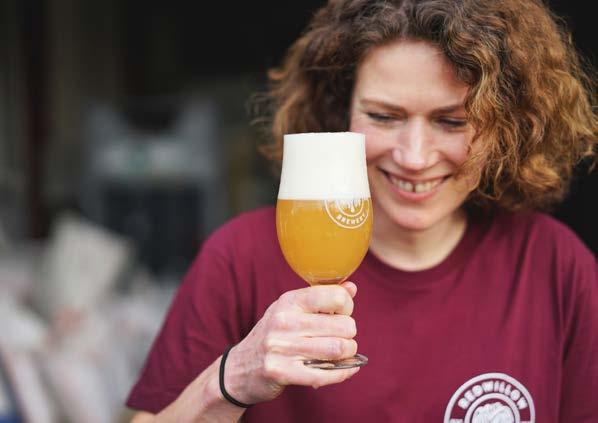
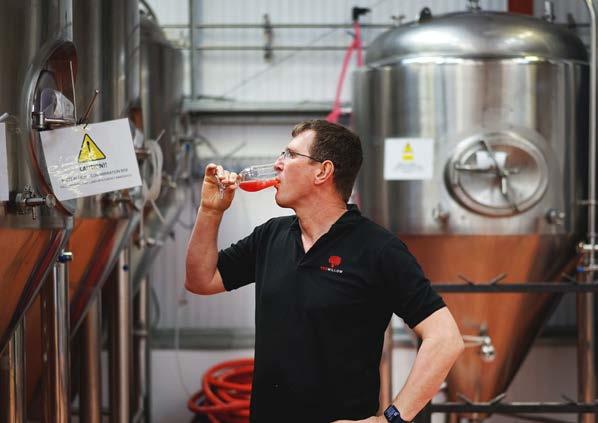
Things were getting busier and busier. We began to hire people and we were knocking out pale beers, best bitters and also some more esoteric beers,” McKenzie recalls.
These included Smokeless, a 5.7% smoked porter infused with chipotles to give even more smokiness and a subtle hint of heat. There was also a 7.2% IPA, also in cask. “It was probably a little bit more of the Wild West back then,” he smiles. “It felt like a moment in the industry where ‘anything goes’. I don’t think you could start like that now. You have to hit the ground running and be a lot more polished than many of our contemporaries were then. Enthusiasm counted for a huge amount at the start.”
But 15 years on, the brewery can thank more than just enthusiasm and hard work for the company’s staying power. And with the latest special releases and collaborations, McKenzie and the team are able to approach these brews with a wealth of knowledge behind them, reimagining some with those 15 years of brewing experience and also the implementation of fresh techniques.
“I think we have learned to be really careful and not to lean into the idea of ‘less is more’. But I think that one of the things we have learned here at RedWillow is that beer needs to be drinkable. You can make styles such as a triple IPA or similar but fundamentally, in my head, you’ve got two types of beer,” he ponders.
“You’ve got the kind of beer that you taste and go ‘wow that’s amazing’ and you end up thinking about that beer long after you’ve finished,” says McKenzie.
“Then on the other side of the spectrum you’ve got a beer that you take a sip of and think ‘Oh, that’s nice. Anyway Bob, how are you?’. For me that’s a social beer and that’s the kind of way that most of us got into this. The beer still needs to be well made and drinkable but it’s not the type of beer where you’re asking yourself how they managed to cram so many hops in. There are beers that are beer-focused and there are beers that
are people-focused. And I like to make people-focused beers.”
Beers like Weightless are just that. Made with 100% Mosaic hops it’s a 4.2% session IPA with pithy grapefruit and mango flavours with a well-rounded body. While Wreckless is a 4.8% American pale. ale loaded with Citra and Amarillo hops providing massive amounts of tropical fruit with a clean finish. And in 2025 these beers are complemented by special releases such as the rebrew of Ageless, a 7.2% IPA from the early days of the brewery’s journey..
“It’s insanely bitter and a really fun beer. It’s one I’ve wanted to make again for the last 15 year so I’m glad we did,” he says.
And brewed in collaboration with The Kernel is Kraftless, which is a golden IPA brewed with Chevalier malt at its heart giving a fresh bread and marmalade backbone layered with resinous, pine and citrus candy, from Amarillo, Simcoe, Columbus, Citra and First Gold hops. It finishes with a dank assertive bitterness.
“When I first started brewing, you would look at The Kernel and think ‘holy crap, these are amazing and completely uncompromising’. So it was really nice of Evin to come up and brew with us. I think Kraftless ended up being a nice intersection and reflection of both of our brewery’s styles.”
There’s also Ageless Anniversary, a reimagination of that very early IPA release. “I have vivid memories of brewing the original back in 2011. Back then, we used all whole hops, adding them in multiple stages throughout the boil,” he says. “Digging out the copper after a brew was an epic effort—a true labour of love!”
To help celebrate their special milestone in 2025 Toby and the team are working with other breweries, too. In addition to a Märzen with Lost and Grounded Brewers of Bristol, a beer that will be lagered until autumn, is a collaboration with Cheltenham-based Deya, which took place in mid-May. “They are all different in their own, separate ways. Lagering the Märzen for that length of
time is arguably a ridiculously stupid idea but one that is super fun,” he says. “And working with Deya is really interesting. We had been back and forth on email for weeks without picking up the phone to each other. It got to the point where I think neither of us were comfortable with the direction the beer was going. So we had a long call and agreed that neither brewery was playing to its strengths and as a result, we’’ve ended up both thrilled with what’s to come.”
And in an ever-changing industry, being in business 15 years in, is not something Toby takes for granted. He recalls Mr Foley’s Cask Ale House in Leeds. At the time it was under the stewardship of Dean Pugh, who would go on to be head of European bar operations for BrewDog before joining Kerb in Berlin.
The popular venue hosted a celebration of IPA back in 2011 but as times have changed, so has the brewing landscape. “There are breweries showcased that day that are no longer with us,” says McKenzie. “And it really does make me think sometimes - how the hell are we still here?”
“One of the things I found when working in London was the realisation that I was completely disconnected from where I lived. But since starting the brewery I’m far more rooted in this part of the world,” he explains.
“We’ve worked with the community and ended up with some amazing, invaluable colleagues. Some of them have been with us for 10 years now. We’ve also made some really good friends in the industry, too..
“I suppose it’s hard not to be proud of what we’ve created. It has been a lot of hard work and a lot of fun. At times it’s terrifying but yes, it’s still a lot of fun!”
Photo credits: RedWillow Brewery
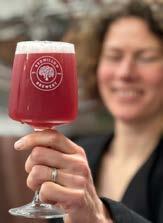

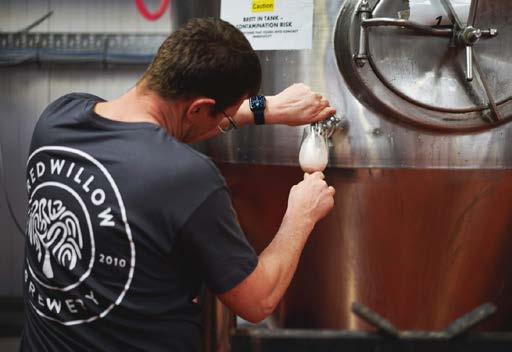
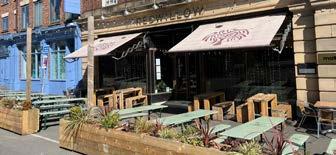
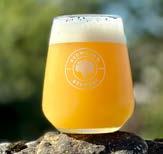
IN THE SIX YEARS SINCE STARTING DURATION BREWING, MIRANDA HUDSON HAS HELPED ESTABLISH THE NORFOLK BREWERY AS ONE OF THE MOST REGARDED IN THE UK. AND AS ANY SMALL BUSINESS OWNER KNOWS, NO DAY OR WEEK IS RARELY THE SAME. IN THIS PIECE SHE EXPLAINS HOW HER AND THE TEAM HELP KEEP DURATION TICKING.
Hlello, I’m Miranda Hudson from Duration Brewing in Norfolk. Six years ago, I took a complete leap of faith opening a modern farmhouse brewery with Bates my husband, our head brewer.
A move that radically changed my life. I’d like to share some insights about what it’s like running a small, passionbased business and what a typical week looks like. Before I jump in here’s a little background on me and Duration.
Our ethos is simple - to make good beer, with good people, in a way that respects where we are. Being on a farm we appreciate the changing seasons. Seeing the swathes of bluebells in spring with the lambs, to the poppies in summer and as harvest starts coming in.
As a former city girl, it’s utterly reenchanting and it inspires a lot of our brew. Herbs, flowers, botanicals and fruit often find their way into recipes as well as all the local grains that are grown and malted here.
We brew fresh modern beers and wild ales, across a broad range of styles. Hop forward pale ales, IPAs, crisp lagers, rich stouts and classic European styles form our fresh Everyday Range. Our Fermata Range of mixed fermentation beers are slower to make - wild ales brewed in the Lambic-Style with great flavour complexity and a distinctly tart character. Focused on sustainability, all of our spent grain goes back to farmers – we feed a wagyu herd, sheep and pigs and help a local blueberry farmer by supplying our spent hops.
When asked to discuss my role whether for a podcast, press article, or in a public talk, I’m always honoured and slightly surprised. I’m not a brewer and this is my first gig in the industry! Regardless, I say yes and never shy away from sharing the obstacles as well as the wins. It’s more real and more interesting to give the whole picture.
I’ve given talks on how it is being a woman in the industry (I like it) and how I navigate my own mental health challenges (I’m bipolar), to how it’s been operating on a knives edge opening right before Brexit and Covid.
Back in 2018 after many months of meticulous research, planning, and fundraising, Bates and I moved to the countryside from London to set about building Duration. While Bates is a seasoned commercial brewer, I had no prior experience in the industry. I had run several small businesses before, and my background is in property development – which certainly came in in handy. We’re located on Abbey Farm in West Acre,
Kings Lynn close to the North Norfolk coast. Our site is on the grounds of a 10th century priory, set in stunning ancient woodlands and farmlands.
It’s not only an SSSI (site of special scientific interest) and one of 134 scheduled monument sites in the UK (think Big Ben, Stone Henge), we are also in a conservation area and the buildings themselves are grade II* listed.
The entire process was a colossal undertaking, not just financially but emotionally but we are so pleased we did all the hard work up front.
We’re in this historic and majestic stone barn that needed a full renovation.
We added a sub-station for power and a water treatment plant before installing a state-of-the-art brewhouse.
The barn renovation itself took 52 weeks and the brewery install, a further 7 weeks. We went for a top of the range 20hL semi-automated BrauKon 3 vessel brewhouse and installed a koelship and 3 foeder crafters to make LambicStyle brews. We have both canning and bottling equipment and since opening we’ve added a lot more tanks and a centrifuge to make the beer more stable and improve our yield and are planning on expanding again!
We decided early on to embrace social media to document our journey and build interest for the project. We shared our ambition as we took a dream and turned it into a reality.
It felt brave and exciting. We sought advice from friends who had established breweries and collaborated - at a time with craft beer was booming – making beers to showcase our intent.
The brewing industry spurred us on, and the public watched with vicarious anticipation. There was no turning back! However, it didn’t take long before our new venture faced unexpected

It’s important to act with conviction but also be open to change,” Miranda Hudson, Duration Brewing
challenges. I mean it’s not every day you dedicate 2 years of your life and uproot your family, spend close to 2 million pounds on a new venture, only to open right as every pub in the country is forcibly closed indefinitely! Covid completely altered the landscape for businesses across the country - our timing couldn’t have been worse. It was a ride or die moment.
As a manufacturer we could stay open but our routes to market were severely hampered and our team of 4 was too small to be furloughed. Thankfully we made it through but at the time with all the uncertainty of how things would play out we simply had to become adaptive and reactive to survive. I learned a great deal about survival in this time. Our team is now at 8 and we have lots of plans.
Since opening in 2019 we’ve trebled our production volumes from 120,000 litres (1.2KhL) a year to around 360,000 litres (3.6KhL). Our brew length is 20HL (2000 litres a batch). Our core and seasonal releases make up 70% of our production volume, the rest is made up of 10% cask specials, and 20% one-off specials - that include all our collaborative brewed and our Lambic-Style releases.
We mostly sell to pubs and bottle shops and have our own online shop and a taproom at the brewery. We also attend 30 or so events and festivals each year. We can’t make enough beer most months - it’s always a juggling act between fan favourites and specials and the plan is to slowly keep adding more tanks as our beer sales grow. Our ambition isn’t to get huge - capping at around 5KhL/yr to remain product and quality focused.
You might be wondering why we are named Duration. There are 3 reasons behind our name: Firstly, Duration is the distance between two beats in musical terms - this relates to our love of both everyday fresh beers and our Lambic styles that can take years to produce. Second, Henri Bergson, a philosopherand failed physicist – a contemporary to Einstein put out the theory of Duration that he called Elon Vital. It pertains that
every creative living thing strives to reinvent itself to stay relevant, which we love and appeals to our ambition to take people somewhere new with beer. Lastly, Duration is a single word, that translates across many languages and is easy to say over a busy bar!!
Not sure there is a typical day for me. I do all the usual things you’d expect of an MD – stakeholder management, director meetings, annual budgeting, hiring, firing, strategy planning, expansion planning. I’m also over a fair few things day-today too - Marketing (website, product assets, press, awards), Events (planning, logistics and working them!) Brewery Retail (running our online shop, brewery shop, taproom and tours) Admin, Finance + HR (phones, customer services, credit control, training staff / SOPS, loading in our systems).
Sunday is for family and socials. Maintaining relationships is crucial in a rural setting like ours, especially across winters which are long, dark and bleak. On Sundays I try to strengthen those connections. I dedicate Sundays to family and socialising, getting quality time with my loved ones and recharging. I play rugby which gives me a great sense of solidarity. I started in lockdown – it was social and legal aggression when life was tough! If there’s no game on a Sunday, then it’s lunch or local day trip with family and friends.
If I do end up working, it’s probably cover in the taproom or an unload at the brewery after a festival or planning out the week’s social posts ahead of a busy week in front of a movie on my lappy.
Monday involves lists, our production meting and sales. Monday mornings are for planning. We set the week’s goals, and I make a detailed to do list to get me ready for a productive week. I get thrown a lot of curve balls and I can get easily side swept and distracted, so lists are essential, everything - however big or small goes on the list. Next, I usually rattle through a few easy weekly tasks -
topping up webshop and brewery shop stocks, deciding what next weekend’s beer line up is going to be in the taproom and ordering supplies before heading into our regular 10am Monday management meeting.
Together with Harry our sales manager and Andy production manager we spend 30mins discussing the wider brew schedule. We agree any schedule changes needed, confirm packaging splits and review recipes in development. We tend to schedule three months out selling a lot on preorder.
We look for any new sales leads, how they may impact stock, we do a little forecasting and run through any pricing requirements or customer issues.
The afternoon is sales focused, profiling what’s coming up to wholesale, and giving a call round key accounts, seeing how trade has been and generally seeing how we can support.
Tuesday is about asset creation and mailers as well as beer launch prep. I work on product assets. These print and digital assets take a recipe through from concept to being a finished product with a unique look and feel. With 3-4 new beers to launch a month - it’s a lot of work but it’s one of my more creative tasks and I love it.
We land on a name, then I think of a specific time and a place where that beer could be enjoyed. I write a 70 words description and select three specific tasting words from the recipe. This goes over to our illustrator Shaun who works his magic on a striking artwork. Then it’s over to the design team to turn my copy and Shaun’s illustration into a label and keg badge and a full set of images – a can, a pour, a six pack and the like.
Once the beer has its unique personality it’s ready to be uploaded into various places like Untappd, our trade sales platforms and in our beer library and online shop. We ship a few samples to a lifestyle photographer to get some shots for socials too and then we are ‘launch ready’. I also use Tuesdays to write two weekly newsletters; one for our trade





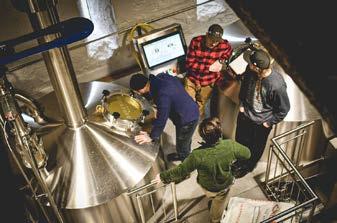
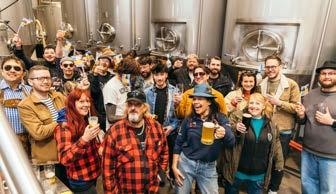

customers and one for everyone else. Again, I love this as it’s putting a little personality behind the products and the brand and I get to talk about what’s yet to come and what’s selling fast, what’s going on at the weekends at the brewery and what events we are attending.
Events and collaborative brews allow us to stay current with trends, engage with our customers, network with our peers, and stay creative and innovative in our work. So on Wednesdays I plan for these – organising the logistics of it all. We attend 30 events a year, anything from music festivals, bars to ‘meet the producer’ events in pubs.
In spring each year, we put on The Great Farmhouse Exploration - a national showcase event that takes place at 20-30 bars and pubs across the UK. We brew special beers, and it takes three months to plan. A great highlight in our social events calendar.
We also have a charity partner –Community Sport Foundation. They drive inclusivity for people with disabilities and are associated with Norwich City Football Club. We raise funds at our events, and this year are busy planning a special release beer with a promotional video to go with it. It’s nice for us and our customers to give back.
Thursdays are when our general mailer goes out, we often give early access to new releases on our mailer. So, I check the webshop is loaded up and that it is ready for launch.
I then turn my attention to our finances and cashflow, ensuring everything is on track and I do some budgeting work. I plan the weekly batch run of payments and make sure our books are in order. It’s tough out there in hospitality right now and we have seen several customers close their doors for good - which presents us with the problem of unpaid bills and needing to find new custom.
I tend to keep a bit of time blocked on Thursday afternoons for any unexpected work – you can’t always plan when things go awry but having a bit of time blocked
for anything that might come up is helpful and stops me panicking when the unexpected does happen. Last week we had a power cut in the brewery because a tractor hit an overhead power line. With 25,000 litres of unfinished beer in our fermentation tanks and a brew underway that could all spoil - we had to act fast, eyeball when the power would be back and get a back-up plan in place for a generator if there was more than a couple of hours outage. Luckily no harm was done but it sucked a full morning out of my week.
Fridays are a mixed bag. I try to wind down a little from the working week reviewing and finishing everything on this week’s list.
I schedule all our socials for the coming week and ensure we are all set to open the taproom on the weekend. The warehouse and production team are off on weekends, so I check our trade portals are good for stock, and I call a few local accounts to check they have enough beer for the weekend.
Pub life is a big thing especially in the countryside, so I tend to end my week with a few cold ones and a catch up at the local - The Stag in our village. It’s great to see everyone – it’s like an extended living room feel – with beer! On Saturdays we open to the public running Tap Days in our barrel store. It’s
dog and family friendly and wheelchair accessible and we aim to be as community focused, welcoming and educational as possible. We offer local street food and enjoy finding customers their perfect beer. We hold monthly brewery tours, and we run a local scheme for discounts on take outs.
I love interacting with our customers, seeing how the beers land, getting vital feedback and being on hand to support the taproom team.
Beer lovers really travel from far and wide to brewery taprooms so it’s not just locals who visit. We launch new products and do our best to create a great inviting atmosphere. We put on special events too at Oktoberfest and Thanksgiving or special Wagyu or Spring Lamb menus and organising and working at these are great fun.
I love the dynamic pace of running a small business and I accept that comes with all the highs and lows. There are these moments of heart-melting joy that feel so pure – like when a customer takes their first gulp of a new beer.
After a brief yet antagonising pause, they begin slowly nodding their head in satisfaction. In these moments all the hard work and worry falls away and I’m filled with immense pride in the team and what we are striving to achieve. It’s bliss.
I love the dynamic pace of running a small business and I accept that comes with all the highs and lows,” Miranda Hudson, Duration Brewing
I do wonder if others pursuing passiondriven careers experience the intensity and oscillating emotions I do surrounding their work. I never fully turn off and it’s like I am in some odd trap of my own making where I feel exhilaration and a strong sense of accomplishment interspersed with dread, mostly low-level, sometimes acute! The feeling is transitory and not unliveable, and I think it actually spurs me on to find more reserves of grit and fortitude when I need it, but I wouldn’t say it’s that relaxing.
I suppose it’s a helpful motivator in moderation when inevitable moments of uncertainty about our future present themselves. Like when key customers go
under owing thousands or the electric bill quadruples or an integral team member decides it’s time to embark on a new adventure. In these moments I try to be practical and accept that nothing stays the same.
I tend to keep a few maxims close to my heart. The first is: Just keep swimming On difficult days, when it feels like everything is falling apart, I remind myself that showing up is half the battle. It’s about facing the day, no matter how challenging, and pushing through—even when I feel unsure of the next step.
The second maxim I live by is: Diamonds are made in the rough. In moments of struggle, I try to remember that pressure can be productive. Even when things feel impossible, I stay focused on the bigger picture and remind myself that with persistence and fortitude things will eventually lead to success.
Lastly, I believe in strong opinions held lightly. It’s important to act with conviction but also be open to change. If new information comes to light, I’m prepared to adapt, listen, and grow.

Running a brewery is far from predictable, but it’s a journey I wouldn’t trade for anything. The highs and lows, the moments of triumph and despair, all come together to create a life that’s full of purpose and passion. It’s a wild ride, but one that I’m fully committed to - and I wouldn’t have it any other way.


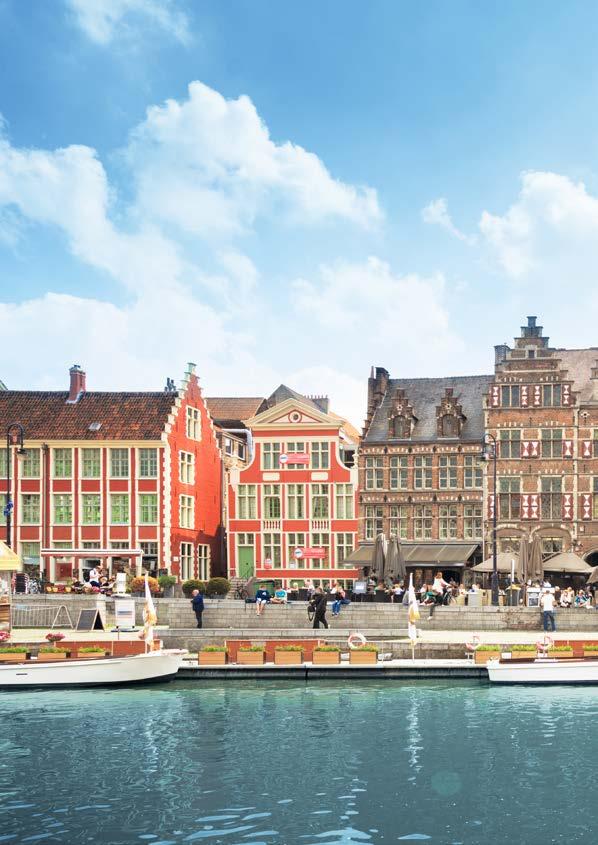
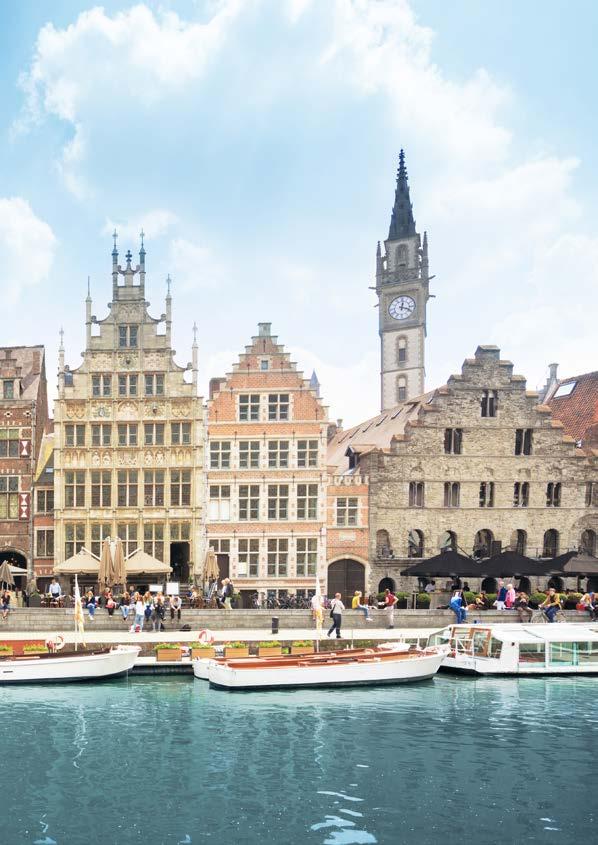
WHILE IT TOOK A WHILE TO WIN OVER PAUL DAVIES, GHENT HAS GONE ON TO BECOME ONE OF HIS FAVOURITE PLACES IN BELGIUM. A REGULAR VISITOR TO THIS FINE CITY, HERE HE EXPLAINS HOW GHENT IS THE PERFECT SHOWCASE OF BOTH STORIED BREWING HERITAGE AND MODERN FORWARD-THINKING BREWERS.
Ihave an embarrassing admission to make. I never really ‘got’ Ghent. While I appreciated the beauty and splendour of its magnificent architecture, on many occasions I failed to reach a destination flagged up in my guidebook.
I always loved spending time in Ghent, visiting friends, checking out breweries and bars and searching for the best Flemish Bolognese. The city’s rich history and canalside settings are certainly worthy of visiting but I really struggled to get around on my numerous visits. I kept getting lost.
Last year I made four visits to the city. Hosting collaborative beer and food events with colleagues, social visits with the family and five days spent in the centre while participating in Brussels Beer Challenge. Familiarity developed a fondness and Ghent is challenging Brugge for my favourite city in Belgium. Years of indifference have faded and the city has started to embrace me like an old friend. Or perhaps a pub regular to be more precise.
Belgium’s third largest city and the capital of East Flanders, Ghent grew from a settlement on the confluence of the Scheldt and Leie rivers to one of the largest and richest cities in Northern Europe by the 14th century. It rose to prominence mainly through trade in cloth and wool. Its textile industry flourished again in the 18th and 19th centuries and the city continued to prosper.
Ghent escaped destruction during the world wars and many of its medieval architecture remains intact. Highlights include St Bavo’s Cathedral, the belfry and the Gravensteen Castle.
The old Graslei harbour retains the numerous merchants’ guild houses (including the Brouwershuis) and is a great spot for people watching.
The city’s student population is vast and gives Ghent its energy. It should be noted that two universities, Universiteit Gent and HOGENT offer courses in brewing technology and have opened a brewing science and technology research facility. Of course the city’s beer and brewing
culture is just as, if not more interesting for me. The city once boasted many brewers and its rich brewing history extends as far back as Roman times with evidence of breweries and malthouses from the 3rd and 4th centuries. During the early and middle ages brewing with gruit (a mixture of herbs and spices) was the norm with reference to gruit stretching back to 974. When Dutch and German beers reached the city in the 14th century things started to change.
Recognising the preservative qualities of these beers brewers began to substitute gruit with hops which gradually saw the use of gruit fade away. The city would go onto to produce a wide range of styles including brown and pale ale, strong dark beers and local wheat beers. Consolidation, closures and increased building costs caused Ghent’s brewers to close or seek more affordable sites outside of the city. Eventually no beer was being brewed within the municipal area at all….
The Gentse Stadsbrouwerij Gruut (Ghent City Brewery) was established by Annick De Splenter in 2009. Annick grew up with hops in her blood, her family owning the former Riva brewery in Dentergem. She choose to take inspiration from the city’s brewing heritage and use Gruut (Flemish for gruit) instead of hops in the brewing process. All of the beers are flavoured in this way with the exception being Inferno, their tripel. They also produce Wit, Blond, Blond (AF), Bruin and Amber.
All their beers can be enjoyed at the brewpub not far from Sint-Jakobskerk where they relocated to in 2016. Nine years passed before Ghent saw another brewery open within the city limits. Bierbrouwerij op Dok Noord (Dok
Clockwise from bottom left: Stroum Brouwers launched in 2021, Gentse Stadsbrouwerij Gruut founded by Annick De Splenter, Stroum produce US-inspired craft beer, contract brewer De Proefbrouwerij, Dok Brewing Company, Belgian tour group enjoying the sights, Brouwerij Van Steenberge in Evergem, founded in 2009 Dok is a Gent success story.
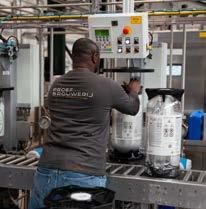
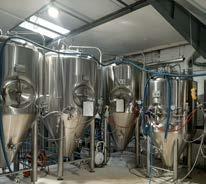

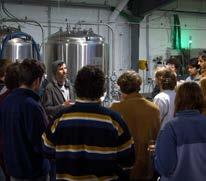
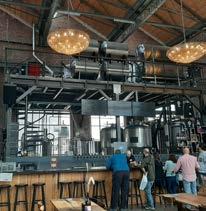



Brewing Company) was launched in 2009 by Janos De Baets, Daniella Provost and Dimitri Messiaen. Janos is formerly of De Proefbrouwerij in nearby Lochristi and is where he started his brewing career. As a side project he also founded Hedonis Ambrachtsbier with his colleague Leopold De Ketelaere. Daniella had launched the L’Arogante beer brand and Dimitri founder of beer company The Ministry of Belgian Beer had launched his Czech-style Pils 13.
Dok is an impressive space with the brewhouse sitting directly behind the bar. Its located in the redeveloped and now trendy area of Dok Noord. The taplist extends to 30 beers mostly from the brewery itself. Guest beers also feature and tap takeovers are common. There is a barrel ageing project also underway beneath the site. To complement the bar three food outlets operate from within the space offering a range of barbecue, burgers and pizza under the ROK brand. Its a fantastic place to visit and spend time pouring over the various beers on tap. They also have their own cafe, Cafe De Welkom on Oudberg.
Brouwers, spreading their love for hoppy IPAs, sours, Kveik and lots more. Their brewery and taproom is located in the Heirnis neighbourhood of the city and here you can indulge your passion for US-inspired craft beer, classic styles and solid Belgians – with a twist. You may even see Farrell giving one of his tours, or just make friends with the brewery cat.
2022 brought another brewery into Ghent and right in the heart of town, right opposite the Stadhuis. Named after Jacob van Artevelde, a revolutionary and statesman of the middle-late middle ages beers bearing his name were produced by Brouwerij Huyghe since 1985. Since the opening of the microbrewery all Artevelde beers are now produced in the city, covering a wide range. The site has become a destination venue with an extensive menu and various spaces to sit and hire should you be looking to host a celebratory event or business meeting.
Familiarity developed a fondness and Ghent is challenging Brugge for my favourite city in Belgium, Paul Davies
In 2018 Colorado native Farrell Styers and three pals founded Humboldt and Gauss started producing crafty beers in the Ghent area. I used to love their beers when I could find them and was always seeking them out. In 2021 he and his Gentenaar mate Carl launched Stroom
Brouwerij Van Steenberge is located in Evergem, just 8km from the city. Founded by Jean Baptiste de Bruin in 1784 the brewery was formerly known as De Peer. It was renamed Bios in 1919 by Paul Van Steenberge who modernised the brewkit and expanded the beer range. In 1962 his son Jozef took over and renamed it after the family.
The brewery is best known for its brands Gulden Draak, Augustijn and Piraat although they also produce other brands including the famous house tripel from De Garre cafe in Brugge. Last year they opened Hopspot, a microbrewery, event space and restaurant just under 3km from the brewery.
Tracing its routes back to 1654, Brouwerij Huyghe was renamed by Leon Huyghe who had worked at the local brewery in the Appelhoek (apple corner) in Melle. He had started work there in 1902 but following the construction of a new brewery building it became Brouwery Leon Huyghe in 1938. A number of smaller breweries and their brands were acquired: Artevelde, Biertoren, Damy, Verlinden and Villers. Their flagship Delerium Tremens was launched in
1988. In 1992 fourth generation Alain De Laet joined the brewery and through careful investment eventually doubled production in 5 years. Construction on a new 7 million euro brewhouse began in 2011, with a focus on reducing energy costs and water consumption. As of 2022 the brewery reported a brewing volume of 270,000 hl with 83% of the beer exported overseas.
Contract brewery De Proefbrouwerij, north east of Ghent in Lochristi began producing high quality beers for its clients in 1996. And those clients are not just confined to Belgium but have included Mikkeller and To Øl from Denmark. The brew kit is high tech and the facility also undertakes R&D projects including ‘single hop technology’ and a project researching the application of yeasts and bacteria in fermentation. They also produce a small range of their own beers under the Reinaert brand. Other small breweries that have established themselves in and around the city include Brauerij Totem in
Evergem who initially started in 2013 as homebrewers. Five years later Klaas Dellaert and Liesbeth Van Raemdonck established their own small facility. Another contract brewery is Beer Select who started in 2016. They now boast two sites north and south west of the city. Heilig Hart Brouwerij was also founded in 2016 and is based further south east in Wetteren. Based in a former church the brewery is stunning and lends itself perfectly to visits and events.
Focussing on natural ingredients, interesting flavours and biodiversity they produce many mixed fermentation beers under their ‘Project Amphora’. South east of Ghent in Merelbeke, De Wilde Brouwers started a year later in 2017. They focus on their Flora range made with organic materials and an average abv of 3.5%. The mixed fermentation beers aged in oak barrels are stronger. A year later microbrewery De Backer launched Pikaflor in Witteren. Owner Steffen focusses on local ingredients and also conducts tours and tastings.
Finally, also in 2018 a former horticultural business and Gasthof was developed into Brouwerij Haeseveld east of the city. The project was financed by three entrepreneurs including Alain De Lait from Huyghe.
The site includes the brewery, brewpub and event hall. Its great news to see Ghent once more establish itself as a brewing city. The bar and cafe scene is excellent with a diverse range of offerings available across the city. I have many favourites to recommend but that will have to wait for another time.
Paul Davies is the founder of AleHunters Brewery Tours. On my journeys he have amassed a huge amount of knowledge of Europe’s bars and breweries, and built up a network of contacts with the key people involved in Belgian’s vibrant beer scene. A resident of London for more than 35 years he has developed an in depth knowledge of the capital’s most iconic pubs and bars.








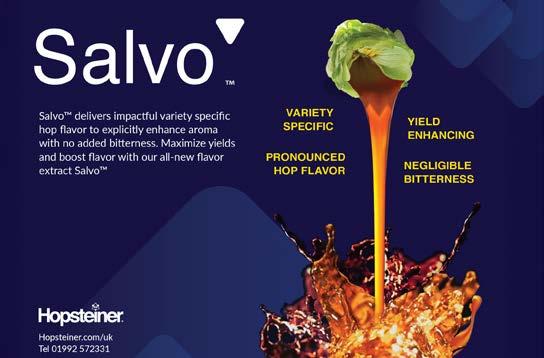















THE JOURNEY BEER TAKES IS ONLY REALLY STARTING ONCE IT LEAVES YOUR BREWERY. AND ENSURING YOUR IT REACHES THE CONSUMER IN THE WAY YOU AND YOUR TEAM INTENDED REQUIRES HIGH-QUALITY PACKAGING AND THE DISTRIBUTION TO MATCH.
The term keg - barrels that protect and help transport beer, has been present in brewing parlance for centuries. And when it comes to the broader idea of wooden barrels, this invention is widely attributed to the Celts around 350 BC.
Closer to the modern day there are records of a patent application for a sheet metal beer keg or barrel submitted by Joseph C. Roth in 1897, while regarded beer writer Gary Gillman notes that Whitbread used ‘keg’ to describe draught beer in 1936, some two decades before the term gained real traction.
The form, and capacity, of these vessels and changed and evolved in that time. Breweries can operate their own fleets of kegs or employ specialist leasing, inventory and tracking firms to handle that side of business.
While on the other side of the spectrum one-way kegs came to market nearly 30 years ago in 1996, growing greatly in popularity some 10 years later when the craft beer movement started to take hold. And when it comes to the handling, distributing and delivering of your brewery’s beers, there are a number of highly regarded options to ensure your product reaches the customer in the condition and timeframe you intended.
In this article we help shine the spotlight on the latest technological developments taking place across this spectrum and then showcase some leading companies in these spaces, too.
In spring, a new keg supply business offering a ‘one stop keg supply shop’ was launched. The Keg Warehouse, which is the brainchild of Darren Duncan, has been founded to offer a raft of keg choices to drinks industry customers. With a wealth of industry experience Duncan is sourcing, storing and supplying a range of keg solutions and accessories from global suppliers to make the keg filling process simple. This includes traditional steels, economy single use plus multi-use as well as longterm reusable “bag in keg” systems.
Duncan tells us that The Keg Warehouse is working with Inoxcva, which he says is a world leading steel keg manufacturer. The have been at the forefront of cryogenic containers for CO2, nitrogen, oxygen, and hydrogen, and have expanded into manufacturing stainless steel kegs for beverage companies. The company’s kegs range from 5L to 1/2 bbl, and they meet EURO, DIN, and US standards. What sets them apart, he says, is their ability to customize kegs to your specific needs—whether it’s sturdiness, ease of handling, or personalized branding.
And elsewhere last month, Loughran Brewers Select announced the addition of 30L UniKeg to their full lineup of KeyKeg products – providing UK brewers with another convenient choice for their keg dispense options. From the same OneCircle family as KeyKeg, UniKeg shares many of the same proven technology and components as the
KeyKeg – and so are equally as sturdy and reliable, but also come with the additional convenience of a universal Sankey fitting. These features are all contained in a slimline, low weight package and are described as being available at a competitive price point.
UniKegs utilise a unique ‘Double Wall’ design as well as an extruded spear. Two PET cylinders form two walls, and this ‘Double Wall’ works together to allow UniKegs to withstand not only very high internal pressures, but also the rough and tumble of the supply chain whilst remaining safe, sturdy and intact. With a universal Sankey (S-Type) coupler, UniKeg fits any CO2, nitrogen or mixedgas dispensing system.
The product is 65% recyclable when empty, and are made from 45% circular materials. UniKegs can be recycled just like KeyKegs, with recycling options throughout the UK via the KeyKeg UK Return Partner network.
Natalie Maestri, KeyKeg sales manager for UK & Ireland explains: “We’ve been working with the team at Loughran Brewers Select for several years—first in Ireland, then in the UK—and have been blown away by the growing demand for KeyKegs. It’s great to see brewers and beverage producers embracing their convenience. Now that UK brewers can source not just the full KeyKeg range but also UniKegs from Loughran Brewers Select, we’re looking forward to seeing even more people enjoying great beer at festivals, pubs, and bars across the UK and beyond.”
At Kammac, which offers Third Party Logistics to the industry, Emma Jones, senior sales manager tells us that the business has just launched BevLink - a dedicated service built specifically for breweries and drinks brands who want “a smarter, more tailored way to manage their logistics”.
She says: “BevLink is designed as a true all-in-one logistics partner, helping drinks brands streamline every stage of their supply chain.
“Whether you’re an ambitious start-up or an established brewery, BevLink offers a smarter, more flexible approach to moving and managing beverages, so you can focus on what you do best: making great drinks.”
Central to this new offering is the company’s experience in offering services such as specialist transport and storage, bonded warehousing, keg sorting as well as B2B and B2C fulfilment. But taking a wider industry viewpoint, Jones is keen to highlight some trends the company is noticing, too.
“Breweries are seeing bigger and sharper peaks in demand, driven by weather patterns, sporting events, and national celebrations. Flexibility is key here. We’ve built systems that allow us to scale operations quickly when needed, whether that’s by adding shifts, expanding temporary storage, or adapting transport plans at short notice,” she explains.
“Sustainability is becoming a real priority rather than just a nice-to-have. Many breweries are looking at ways to reduce their environmental footprint.
“We’ve been working on making our logistics operations greener too, including partnering with Encirc to cut plastic use through initiatives like de-shrouding pallets and using tension banding guns - improving both product stability and sustainability.”
And looking ahead, Jones says brewing businesses should pay careful attention to the important upcoming changes
regarding alcohol labelling changes in the Republic of Ireland. These new regulations are expected to impact how alcoholic beverages are labelled, and breweries will need to update their labels to ensure compliance.
“There are practical solutions available - from re-labelling stock to co-packing new product lines - and we are already set up to help with this if needed.
“Our certifications, including FHDDS and AEO, also mean we can support exports efficiently, helping brands navigate any knock-on effects in European markets,” she explains. “Whether breweries decide to handle changes independently or work with partners, being proactive will make all the difference in staying ahead.”
Also in the drinks logistics space are Tap’in, which offer specialist drinks logistics solutions tailored specifically for the drinks industry. “Tap’in is an efficient, cost-effective and sustainable logistics solution for breweries that want to grow their business in London, whilst streamlining their operations without the complexities of managing the logistics themselves,” explains Kieron Summerhayes, who is the sales director at the business.
“While we may not be the right fit for everyone, particularly those without sales teams or those that don’t meet our MOQ, our service does put an alternative option for breweries on the table.”
And further into 2025 and beyond Summerhayes says the business is making great strides to further cater for
its brewing clients. “A key development is our ongoing effort to integrate with Breww software, the platform most of our brewery customers already use,” he says. “This integration will enable seamless data transfer between systems, reducing manual input and minimising the potential for errors. By streamlining this process, we aim to save breweries valuable time, improve accuracy, and also to enhance operational efficiency.”
He adds: “Furthermore, we continue to innovate within our own systems to increase efficiency across all stages of the supply chain. This includes optimising delivery routes, improving warehouse management, and expanding our scalable storage solutions to help breweries handle increasing demand.
“Our commitment to sustainability remains at the forefront, as we look for ways to further reduce emissions and consolidate deliveries, benefiting both the environment and your bottom line.”

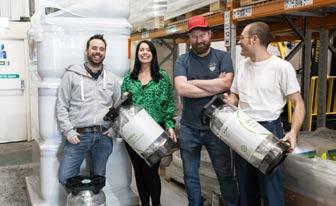
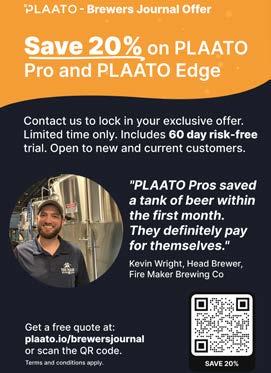





SPEEDS UP TO 250 CPM, IN A FOOTPRINT THAT FITS!
SMOOTHER OPERATION IMPROVES CAN HANDLING AND LOWERS THE RISK OF CAN DAMAGE
MECHANICALLY-SYNCHRONIZED LID APPLICATION ENSURES CONSISTENT AND REPEATABLE DOUBLE SEAM INTEGRITY
SMOOTH, CONTINUOUS MOTION TRANSITION FROM FILLING TO SEAMING ELIMINATES UNNECESSARY AGITATION AND CO₂ Loss
NOW AVAILABLE IN 12/3, 16/4, AND 24/4 FILL VALVE/SEAMER HEAD CONFIGURATIONS

KEGS AND CASKS ARE AN INTEGRAL FACET OF THE BEER LANDSCAPE, AS ARE THE COMPANIES THAT MANUFACTURE, SUPPLY AND DISTRIBUTE THESE VESSELS.
At Keg Logistics, they prioritise sustainability by offering top-quality, reusable stainless steel brewery kegs, casks and pins. Their range includes 50-litre kegs, 30-litre kegs, 20-litre kegs, 4.5-gallon pins, and 9-gallon casks, all designed to reduce waste and promote environmental responsibility. Keg Logistics provides fully branded, laser-etched kegs in your custom colours, delivered as soon as 7-10 days from the order date. They provide your brewery with unmatched flexibility, allowing you to rent a single increment and reorder as needed without any exclusivity agreements. By choosing their ecofriendly kegs, you contribute to a greener future for the brewing industry.
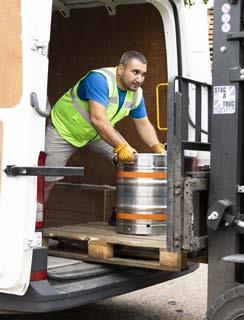

Tap’in provides specialist drinks logistics solutions tailored specifically for the drinks industry. The company’s core mission is to be the ‘Operations Team of Your Dreams’, ensuring products are delivered on time, every time. They offer an alternative route to wholesalers that empowers brewers to control their margins and relationships with venues. Their logistics service allows breweries to focus on brewing, while we handle the logistics. Tap’in’s warehouse is located just 5 miles from London which means they can offer frequent deliveries- four days a week to London and twice a week to Brighton and the Home Counties. This gives breweries the flexibility they need while allowing them to maintain control and ownership of their venue relationships.
They pride themselves in offering flexible scheduling and next-day deliveries to their clients, allowing them to have control while still benefitting from our outsourced logistics. Their clients appreciate the flexibility they provide; if orders are sent in to us by 2pm, they aim to deliver next day, which helps producers to adapt to a sudden spike in demand. This combination of efficiency and customer-focused service is why they receive numerous referrals from satisfied clients.

Kegstar is capable of partnering with brewers ranging from small startups to the largest, most sophisticated breweries in the world. They are built on the simple idea that sharing is better. As the trusted steward of the world’s most extensive shared keg supply chain, they manage a global, circular keg infrastructure built for scalability over the long term with one purpose at its core: to build long-lasting customer partnerships that not only benefit each individual brewer, but the entire industry, and the planet. By existing to serve all three, they enable enduring shareability. With more than 50 years of experience, leading-edge technology, and unparalleled know how, millions of kegs flow through their quality centers each year to be returned to like new condition.

Nicwood logistics runs eight warehouses with a capacity of 140,000 sq. ft. it also runs a dedicated fleet of vans and trucks all-round the UK and Europe this family run business always goes that extra mile for its blue chip customer big or small and looks after the 45 members of staff who continually look after our customers.
They boast 25 articulated lorries, 11 vans, 4 18ton and 2 7.5ton. This also covers a wide range of trailer types from curtain, curtain tail lift, flats and trombone trailers. They are currently working along side a range of UK breweries to provide storage and logistics to ensure there product arrives on time in good condition to there customers as and when they need it. Do you operate with JIT in your supply chain? They can hold and stock your products and then deliver in to you on your request, to meet you short leaded times and keep production going.
Konvoy is disrupting the beverage industry with its smart IoT keg tracking technology and innovative business model to reduce friction in keg logistics, from brewer to venue and back again. Konvoy offers flat-rate, short- and long-term pay-per-fill keg pooling, pay-per-month keg rental, and its proven IoT keg tracking solution to help your draft drinks become more efficient, effective, circular and sustainable. “We’re here for your beer, with unparalleled experience, service and care.” The company says they track every keg’s location to reduce losses and help improve margins. And they are here to service and maintain your kegs to minimize costly downtime.

EkegPlus from Close Brothers Brewery Rentals is a container rental pooling service that gives you more flexibility. Their keg and cask solution allows you, the brewer, to only pay for the time you use containers –with prices starting at just 99p for 31 days. Every time the containers you’re using are scanned, the data is logged on the PlusPortal management system. This allows you to trace the progress of your product throughout the supply chain – from fill to closing the hire cycle.
Their outsourced keg and cask solution allows brewers to only pay for the time they use containers – with prices starting at just 99 pence for 30 days. With access to our fleet of over 400,000 ekegs and ecasks, you have the freedom to adjust usage and costs as required. Simply keep the stockpile of containers you need onsite, or collect and refill from a range of locations. Each container is embedded with RFID technology, making it uniquely identifiable. After you’ve scanned an ekeg or ecask into a hire cycle, you can then track where your product is and how much it’s going to cost on their PlusPortal management platform.
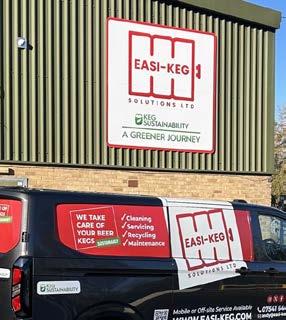

Easi-Keg are a leading industry innovator within the brewing and keg industry. They have revolutionized the way kegs are cleaned, using state-of-the-art technology that ensures a thorough and efficient cleaning process. Their commitment to sustainability is evident in their use of eco-friendly cleaning products and their efforts to reduce water waste. With our outstanding reputation and unparalleled expertise, we have become a trusted partner for breweries and other businesses in the keg industry. Beer keg cleaning, recycling, and sustainability are all important aspects of the brewing industry.
Proper cleaning and maintenance of kegs ensure that beer quality is maintained and that they last longer, reducing waste and saving money. Recycling of kegs is also crucial to reduce environmental impact and promote sustainability. Many breweries now use stainless steel kegs that can be reused for decades, and some even incorporate recycled materials into their kegs. By promoting responsible keg cleaning and recycling practices, the brewing industry can continue to produce quality beer while reducing their carbon footprint.

Kammac supports four of the five biggest breweries in the UK, with many partnerships lasting over a decade. It’s something they are really proud ofnot because it’s about them, but because it shows what’s possible when you build genuine, long-term relationships with customers who trust you to deliver.
As an ecommerce fulfilment service, they pride themselves on being your trusted logistics partner. Their warehousing solutions are efficient and secure, providing you with flexible storage options for your products.
Their pick and pack process is handled by their in-house experts, who will manage the set up and execution to ensure your orders are completed quickly, carefully, and in excellent condition. The company works with all major delivery companies to ensure you are able to offer your customers affordable shipping options.
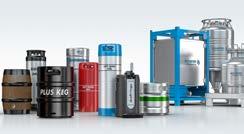
Since 1978, Schaefer has been setting standards in the production of high-quality container systems for beverages and stainless steel containers for liquids, solid bulk materials and granulate. Over 25 million kegs sold and our drive for innovation makes us the ideal partner to meet your stainless steel container needs. Their Our mission is to manufacture and distribute a variety of stainless steel containers. They believe in sustainability and design our containers to be long-lasting.
They care about the quality of their products because they hold yours. Whether for beer, wine, soft drinks, coffee or water, as a full-range supplier, Schaefer Container Systems has the right reusable keg for every beverage. All over the world millions of Schaefer KEGs are used by internationally renowned beverage producers as well as small regional businesses. They manufacture exclusively reusable products on the basis of high-grade stainless steel.
A significant percentage of brewers do not track their beer kegs and casks. Refill cycle times are compromised because of a lack of an effective and affordable monitoring solution. Now with i-Keg plastic keg, casks, retrofittable tag and spear solutions, brewers can monitor each keg throughout the process from factory gate to refill, providing a secure track and trace system with industry compliant product traceability. For brewers who demand reliability and precision, they are a trusted industry choice. The company’s innovative solutions, from smart kegs to retrofittable tracking systems, are designed to streamline operations, improve traceability and reduce costs. With industry leading technology and a commitment to quality, they are proud to be the partner that helps you stay ahead of the competition.
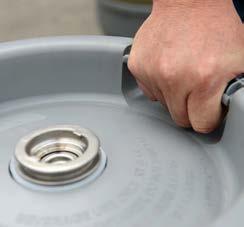
WORKING WITH COLLECTIVE MOTION BREWING AND CLOSE BROTHERS BREWERY RENTALS, BRISTOL-BASED LEFT HANDED GIANT HAS OVERHAULED ITS KEG OPERATION. HERE IS HOW THEY DID IT.
Left Handed Giant Brewery is known for its innovation, sustainability, and highquality brewing practices.
The brewery’s commitment to eco-friendly production processes has led them to adopt various sustainable practices, including energy-efficient systems and only using locally sourced ingredients, where possible.
One area; however, that presented a significant challenge was keg washing. This vital, but often overlooked, part of the brewing process can directly impact the quality of beer and have a material environmental impact, something they wanted to avoid.
With over 200 kegs in circulation, Left Handed Giant Brewery faced issues with storage, cleaning, and availability. Without an on-site keg washing facility, ensuring kegs were consistently clean was costly, leading to operational delays.
Limited storage space added to the problem because the brewery had to simultaneously manage clean kegs and those waiting for off-site cleaning, ensuring they were kept separate.
To improve efficiency and reduce the environmental impact of transporting kegs, Left Handed Giant Brewery invested in a CCC-V2 Automatic Keg Washer, supplied by Collective Motion Brewing. This high-performance washer can clean up to 38 kegs every hour, featuring customisable wash cycles, steam sterilisation, and energy-saving technologies.
Richard Poole, technical brewing director at Left Handed Giant Brewery, explained: “The Collective Motion Brewing keg washer has given us greater control over stock levels and streamlined our operations. It’s been a game-changer for both efficiency and quality.”
Arthur O’Toole, head of sales at Collective Motion Brewing added: “The machine is user-friendly, and staff can be trained efficiently, providing the team with increased flexibility to meet tight deadlines and unexpected demands. Their goal was to optimise the storage on site and reduce operational cost, and I’m delighted we were able to help them achieve this.”
In addition to using its own kegs, Left Handed Giant Brewery has been renting them from Close Brothers Brewery Rentals for several years. With the new on-site washing capabilities, the brewery transitioned to EkegPlus, a flexible ‘payas-you-fill’ rental system. This model allows Left Handed Giant Brewery to only pay for kegs when they use them, reducing costs and improving control over their fleet.
Ray Morrisey, business development manager at Close Brothers commented: “Left-Handed Giant is in a great position to benefit from our EkegPlus model. “There are a lot of Ekeg users in their area and with access to this shared pool of containers, as and when they need them, the brewery can improve stock management, reduce reliance on exact forecasting and respond quickly to last minute demand without waiting for a
delivery of kegs. They are also freeing up space for venues by collecting empty, unwashed kegs and returning them to the supply chain.”
The combination of the Collective Motion Brewing keg washer and EkegPlus has transformed Left Handed Giant Brewery’s operations. The ability to clean and reuse kegs more efficiently has improved their stock management and reduced unnecessary transport runs. This has resulted in significant reductions in carbon emissions, aligning closely with the brewery’s sustainability goals.
Poole noted: “The ability to clean and reuse kegs locally has reduced transport emissions and improved our sustainability. The flexibility and cost savings from EkegPlus have been crucial in maintaining efficiency.”
Looking to the future, this partnership provides a firm foundation for the brewery’s growth and further commitment to sustainability. The brewery can now offer contract cleaning services to other breweries, creating new opportunities. The collaboration between Left Handed Giant Brewery, Collective Motion Brewing, and Close Brothers Brewery Rentals showcases how suppliers and breweries can work together to solve industry challenges.
Poole concluded: “Having the Collective Motion Brewing washer and EkegPlus has given us the flexibility, efficiency, and sustainability we needed.
“We’re washing more kegs, reducing waste, and operating more efficiently than ever.”
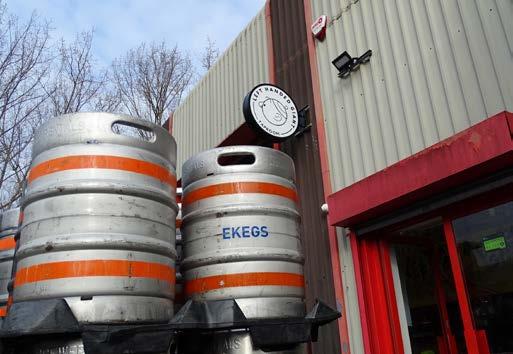
































































www.certuss-emx.com/en



ELEVATING
IMPROVING
SUPPORTING
In the modern, competitive brewing industry, branding is everything. From the name of the beer to the design of the can or bottle, every detail matters when it comes to shaping customer perceptions and standing out in a crowded market.
However, one essential component often goes unnoticed in the broader brand conversation: the humble keg collar. Traditionally seen as a compliance tool to provide regulatory information, keg collars are often treated as an afterthought. But in reality, they present a unique opportunity for breweries to reinforce their identity, communicate professionalism, and even enhance the customer experience, both at trade and consumer level.
At a basic level, keg collars serve a critical regulatory function. They carry information required by law, which includes alcohol content, allergens, product names, best-before dates, and batch codes. For health and safety reasons, this information must be accurate and clearly legible.
Yet while these practical details are nonnegotiable, the way they’re presented doesn’t have to be plain or generic. As with any piece of packaging, design choices, colour, typography, layout, material and finish, play a vital role in communicating brand personality. A poorly designed keg collar may still tick the compliance box, but it misses
a valuable opportunity to support the brand it represents. Keg collars are more visible than many breweries might think. In a bar cellar, a distributor’s warehouse, or an event keg line-up, the collar may be the only visual cue available to identify what’s in the keg. It becomes a point of reference for bar staff, event organisers and distributors when making decisions about what to promote, display or serve.
In this sense, the keg collar acts as a miniature billboard. Clear, well-branded designs stand out amongst a sea of plain or inconsistent labels. They make it easier for people to find your product, remember it, and associate it with professionalism and care. In a busy hospitality environment, these small visual cues can have a surprisingly big impact on the customer and consumer.
As brand consistency becomes increasingly important in driving recognition and trust, keg collars offer a valuable opportunity to reinforce the visual identity that’s present across cans, bottles, pump clips and merchandise. A collar that mirrors your wider brand colours, logo placement, and tone of voice creates cohesion, strengthening the overall identity in the minds of trade customers and consumers.
Design elements such as colour coding different beer styles or using illustrations that match core range labels can also aid logistics and front-of-house service, helping bar staff quickly distinguish
between products. The more consistent and intuitive your print materials are, the more confidence they inspire. Keg collars also play an important practical role in supporting brewery operations. They make stock easier to manage, allow for clearer batch traceability, and can help reduce errors in fast-paced environments.
For example, including clearly printed batch numbers or filling dates on each collar can support quality control or simplify internal record keeping. For breweries working with multiple third-party venues or distributors, collars are often the only communication method that travels with the keg, so clarity is essential. Poor print quality, ink smudging, or inconsistent sizing can cause delays, confusion, or incorrect pours. Choosing robust print materials with water-resistant coatings ensures information stays legible even when kegs are stored in cold or damp conditions.
As more breweries look to differentiate themselves with storytelling and deeper brand narratives, keg collars can also become a vehicle for creative engagement. While space is limited, some breweries are using collars to share tasting notes, brief brand bios, or QR codes that link to videos or web content. Interactive design elements like these can drive engagement with consumers at taprooms or festivals, where customers are curious about what they’re drinking. A QR code linking to a digital menu,

music playlist, or brewing process video can add an extra layer of experience to a pint, encouraging connection beyond the pour. With increased focus on environmentally responsible practices across the brewing industry, sustainable materials are becoming a key consideration for all forms of packaging, including keg collars.
Switching to recycled paper stocks, using vegetable-based inks, or reducing plastic content are all feasible choices that can lower environmental impact. Some printers, like us also offer FSCcertified options. Not only do these choices align with more environmentally responsible business practices, but they also resonate with today’s more ecoconscious consumers. Breweries who align their brand with sustainability often find that even these small decisions help to strengthen their reputation and values in the marketplace. While a keg collar might be disposed of after a keg is finished, the message it sends about your brand can stick around for far longer. The impact of poorly executed keg
collars shouldn’t be underestimated. Bad print quality, incorrect information, or clumsy design can reflect badly on a brand, suggesting carelessness or inconsistency. In practical terms, this can also lead to errors in bar service, missed promotional opportunities, or even issues with compliance if mandatory information is obscured or missing.
Given the relatively low cost of producing keg collars compared to other forms of packaging, it makes commercial sense to do them properly. The return on investment isn’t just visual, it’s operational, reputational, and regulatory. This is why working with an experienced print partner is key.
We work with breweries across the UK to produce high-quality, splash-resistant keg collars that not only meet regulatory standards but also help reinforce brand identity. An experienced print partner understands the importance of durable materials, colour consistency, and design integrity, even for small-format print products like keg collars.
These may be small, but they punch above their weight when it comes to brand communication and functionality. In a market where attention to detail and customer experience are key, treating the collar as an integrated part of the brand, rather than a printing afterthought, can make all the difference.
From elevating brand consistency and improving trade relationships to supporting sustainable values and providing operational clarity, there’s a lot more to the keg collar than meets the eye. As the craft beer market continues to grow, those breweries that pay attention to these finer details will be the ones that leave a lasting impression, on the bar and beyond.
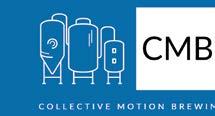





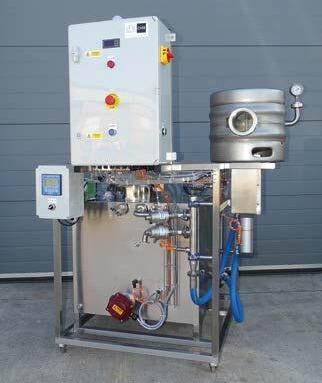




Rich Poole, Left Handed Giant


AN INCREASING NUMBER OF BREWERIES ARE INVESTING IN CO2 RECOVERY SYSTEMS AND TECHNOLOGY SUCH AS NITROGEN GENERATORS AS ALTERNATIVES TO BOUGHT CO2. BUT WHY SHOULD YOU BOTHER? HERE ARE SOME OF THE BENEFITS, BOTH ECONOMIC
Breweries are operating in an increasingly environmentally conscious world. And for many consumers a great product is no longer enough of a sales proposition. The sustainable practices employed by the business in question are often just as important.
One way breweries are boosting their sustainability credentials and cutting costs in the process is through the implementation of CO2 recovery.
CO2 recovery is the process of capturing carbon dioxide produced during fermentation and other brewery processes. This is then purified and used within the brewery. This process involves several stages namely compression, purification, liquefaction, and storage. The system prevents the waste of CO2 but also ensures that the brewery has a steady supply of this critical gas for various stages of beer production.
An increasing number of breweries are investing in this technology but what more is there to learn and where should you turn if you are planning to add CO2 recovery or nitrogen generation to your operation? In this article we speak to some of the leading names in these spaces to find out more and to also, address and dispel some myths.
“A common belief is that CO2 recovery technology is exclusively suited for extensive, large-scale brewing operations. However, this is no longer
the case,” explains Frederik Degn Dalum from Dalum Beverage Equipment.
“Modern, compact CO2 recovery units have been developed that are economically viable for small and medium-sized craft breweries. For instance, our systems are designed for breweries producing as little as 1,000 hL annually, with entry-level investment costs making the technology more accessible. In regions where commercial CO2 prices are particularly high, the ROI for such a system can be realized in as little as one year.
“In areas with more moderate CO2 costs, the payback period might be slightly longer. This adaptability in financial return makes CO2 recovery a feasible consideration for a wide spectrum of brewing businesses looking to curtail operational expenses and enhance their environmental stewardship.”
Another myth Frederik Degn Dalum is keen to dispel is CO2 is so plentiful and inexpensive that recovery is unnecessary.
“While it’s true that carbon dioxide is a component of the Earth’s atmosphere (around 0.04%), the commercial-grade CO2 required for beverage production is not always so easy to come by.
“Numerous breweries rely on purchased CO2, but the market for this gas can be volatile due to supply chain disruptions, which directly affects both cost and consistent availability,” he explains.
Dalum says that in recent years, CO2 shortages have created substantial difficulties for breweries in various parts
of the world, including Europe, North America, and Australia, as well as island nations. These disruptions have led to dramatic price increases for CO2, sometimes reaching up to six times previous levels in certain areas, even before factoring in additional surcharges. For example, in the United Kingdom, the brewing sector saw CO2 prices escalate by at least 300% between 2020 and 2021, accompanied by widespread shortages that seriously hampered production. Some areas faced such critical supply chain failures that demand for CO2 could
A common belief is that CO2 recovery technology is exclusively suited for extensive, largescale brewing operations. This is no longer the case,” Frederik Degn Dalum, Dalum

not be met, forcing some breweries to halt operations temporarily, while a few had to close permanently.
He adds: “Some brewing operations reported paying approximately £250 per tonne for CO2 in 2016, only to see that figure jump to around £1,000 per tonne by 2021.
“Other breweries have also reported struggles with reliable CO2 supply, which motivated them to install recovery units to secure their future operations.
“By investing in a CO2 recovery system, beverage producers can significantly reduce or eliminate their dependence on external CO2 suppliers, thereby lowering operational costs and lessening their environmental impact.”
And for those concerned that recovered CO2 does not meet purity standards for beverage production, this is not the case.
One of the most main misconceptions is that CO2 recovered during the fermentation process is not pure enough for use in food and beverage applications, he tells us.
“In truth, advanced craft-scale CO2 recovery systems are specifically engineered to meet, and often exceed, established beverage-grade purity standards such as ISBT,” explains Dalum. “Through meticulous purification and processing steps, these systems can deliver high-purity CO2 that is entirely safe and suitable for direct use in beverages, with the added benefit
of being sourced directly from the brewery’s own fermentation.
He says: “Our customers have conducted their own purity tests using industrystandard equipment, which confirms purity levels exceeding 99.99%.
“This shows the level of quality control attainable. Craft breweries can thereby ensure a consistent supply of beveragegrade CO2, free from the purity or quality fluctuations that can sometimes occur with externally sourced CO2.
For SSV Limited, a leading supplier of equipment such as brew-blocs and tanks as well as CO2 technology and more, brewers are placing an even greater emphasis on their carbon footprints, so it’s key they have access to the technology that can help them achieve these goals. They explain that it used to be the case that purchasing CO2 was quick, easy and cost effective.
But that doesn’t hold true today. CO2 supply chains have become less reliable, costs have soared and, perhaps most importantly, brewers are taking a hard look at their carbon footprints. This is why the business partnered with CO2 specialist Hypro, to offer CO2 recovery systems allowing brewers to easily adapt production processes to brew greener.
They say: “Our HyCrC range is the result of this collaboration. It’s ideal for the craft beer sector, being both compact in size, yet creating hygienic, food grade CO2 of the highest purity levels.
“As an added bonus it’s designed to be
energy efficient, doubling down on both the green and economic credentials of investing in CO2 recovery. We offer this market-leading equipment to our customer as part of a turnkey service that covers sales, installation, integration, commissioning and after care, with recovery solutions starting from 6kg/ph and going up to 10,000kg/ph.”
Key features of this technology include units from 15 to 3000 kg/hr Liquid CO2 recovery, produces CO2 with purity in excess of 99.998% v/v and 100% food-
“HyCrC is ideal for the craft beer sector, being both compact, yet creating hygienic, food grade CO2,” SSV LTD
grade CO2 ready for reuse from a known source with full traceability.
And at Atlas Copco, which supplies the brewing industry with oil-free compressors and nitrogen generators as well as vacuum pumps and process filtration systems, they say that the company’s CO2 recovery system enables breweries to sustain and also exceed their own carbon dioxide needs.
Crucially, the payback period of a CO2 compressor is often around two years, yielding a swift return on investment for other improvements, they explain.
Alongside CO2 recovery, they offer various compressed air solutions which comply with ISO 8573-1 norms ). Oil-free compressors are recommended for sensitive processes like aeration, bottling, and kegging, where contamination risks must be avoided in order to safeguard the beer’s taste, aroma and foam. Oil-injected compressors with the proper air treatment are also available for
applications such as controlling valves and actuators in packaging or labelling machinery and for feeding nitrogen generators. For breweries facing CO2 supply issues, nitrogen gas is a cheaper and more readily available alternative for at least two-thirds of applications across the brewing process.
Systems like Atlas Copco’s on-site nitrogen generators produce nitrogen on demand, and at the required purity, essential for flushing, purging, and pressurising. By limiting reliance on external nitrogen cylinder deliveries, breweries gain control over gas availability and purity. This approach lowers costs, reduces environmental impact, removes certain safety and logistics concerns, and keeps vital processes uninterrupted.
“Recent years have shown how reliant breweries often are on external CO2 supplies, creating challenges when costs surge or supply lines falter,” explains Andrew Butler from Atlas Copco. “Many breweries are therefore substituting carbon dioxide with nitrogen in many brewing applications to ensure production stability and reduce longterm overheads.”
Pneumatech also offer nitrogen generators as a CO2 alternative for breweries. They supply Pressure swing adsorption (PSA) generators which allow companies to produce their own nitrogen instead of relying on third-party vendors. This offers wide-ranging benefits, such as lower costs, reduced logistics, and increased flexibility. They also supply Membrane nitrogen generators, which utilize semi-permeable membranes to separate nitrogen gas from the surrounding air, providing a continuous and on-site source of high-purity nitrogen gas without the need for traditional nitrogen storage or delivery systems.
“In both 2018 and 2022, there have been CO2 crises which have highlighted the vulnerability of the supply chain. By taking control of their own supply, savvy brewers are reducing the reliance on third-party gas availability and the headaches this can bring,” Craig Smith, business development manager for Pneumatech in the UK & Ireland.
“The brewing industry is one of the most conscious when it comes to their impact on the planet, which is commendable. “Many industries treat sustainability as a ‘nice-to-have’ where brewers, in the main, treat it as a genuine priority. Reducing their CO2 consumption and introducing nitrogen generation, it has a huge impact on the carbon footprint of a brewery’s beer.”
Another company is the CO2 space is Earthly Labs, whose technology creates a circular economy affordably capturing, purifying and liquefying carbon dioxide for re-use. Improving sustainability, reducing costs and mitigating against supply chain issues. CO2 recovery and also re-use.
And since 2016 CiCi technology has been simultaneously eliminating emissions and reducing costs and supply chain volatility through a circular economy where carbon dioxide from the fermentation process is affordably captured, purified, liquefied and returned at >99.9% purity for re-use during carbonation. In a three step process, gas is dried to remove moisture, scrubbed to remove volatile organic compounds (VOCs) and other impurities, and chilled below -34.7 °C to convert carbon dioxide gas to a liquid. Their CiCi range spans three models and is suitable for brew pubs with an annual production
Recent years have shown how reliant breweries often are on external CO2 supplies, creating challenges when costs surge,” Andrew Butler Atlas
around 2K hL all the way to much larger operations producing >200K hL.
With a small footprint, the system can fit into existing spaces and begin recovering CO2 for re-use immediately after installation. Specially developed software controls gas processing for 24/7 unmanned operation with full system updates and carbon capture volumes available remotely in real time.Pioneered and proven in the US, CiCi is now available across Europe

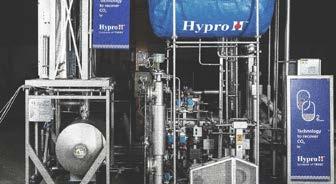
with manufacturing in Germany and aftermarket support from 22 centres.
Returning to Frederik Degn Dalum from Dalum Beverage Equipment, he highlights are two myths surrounding CO2 recovery that he is keen to banish. According to the manufacturer, there is a common belief that CO2 recovery systems designed for craft breweries are incapable of recovering a sufficient volume of CO2 to meet all of a brewery’s needs. However, he says, many modern systems are engineered to efficiently recover CO2 from fermentation.
“Our recovery rate is around 3.4 kg of CO2 per hL produced. For many breweries, this recovered amount is adequate to cover their requirements for carbonation, tank purging, and various other applications, contingent on their production scale and specific CO2 usage practices,” he says. “Achieving CO2 independence hinges on maximising collection efficiency and also minimising gas wastage.
“If a brewery’s fermentation schedule is not optimally managed for recovery, there’s a potential for recoverable CO2 to be lost. For instance, if multiple fermenters are not connected to the recovery system at the opportune times, valuable gas might vent uncollected.”
For Dalum, experience shows however that breweries become more adept at utilising their CO2 recovery system over time. By gaining a deeper understanding of how the system integrates with their processes and by adjusting schedules accordingly, brewers can significantly
increase their CO2 recovery rates and reduce unnecessary losses.
It’s also observed that some breweries may initially use more CO2 than is strictly necessary, but through process refinement, they become more efficient in their overall CO2 consumption. Indeed, some breweries find they can recover more CO2 than they currently require for their own operations. This surplus can be sold to draft customers and other local businesses, which creates an additional revenue stream, particularly in areas where CO2 is expensive or difficult to source.
He says: “In Scotland, one customer has reported annual CO2 production of 50 tonnes while only consuming 35 tonnes, which leaves a significant excess.
“The Danish brewery, Svaneke Bryghus, located on a remote island where CO2 is especially costly, has successfully sold their surplus CO2 to nearby businesses for several years.
“It’s worth noting that breweries with a high proportion of their product packaged in cans (e.g., over 50%) may find complete CO2 independence more challenging, as canning lines typically require substantial volumes of CO2.”
“These breweries should carefully analyse their current CO2 consumption against the anticipated recovery yield from a system,” says Dalum. “We can provide detailed analyses to assist with this assessment. In situations where CO2 recovery alone might not meet the total demand, breweries can explore
supplementing their CO2 supply with a nitrogen generator.
“Nitrogen is utilised in various brewing and packaging stages, and a nitrogen generator can help bridge any gap to ensure full CO2 self-sufficiency.
“Combining CO2 recovery with nitrogen generation can offer a robust and costeffective path to independence from external gas suppliers and a potential new incremental revenue stream.”
And finally, he tells us that there is a common misconception that CO2 cannot be collected from multiple fermentation tanks simultaneously. “It’s sometimes mistakenly believed that CO2 recovery systems are restricted to recovering gas from only one fermenter at a time. In reality, some CO2 recovery plants, like our system, are designed and appropriately sized to manage CO2 collection from several fermenters concurrently,” he explains.
“This capability makes them well-suited for breweries of all operational scales and facilitates more efficient CO2 recovery across a range of fermenters, whether large or small. This inherent flexibility ensures that breweries can maximise CO2 recovery from all active fermentation stages, thereby reducing waste and enhancing the overall sustainability of their operations.”
Looking ahead to 2025 and beyond, Andrew Butler from Atlas Copco concludes by telling us that rising CO₂ prices, supply chain volatility, and net zero ambitions are pushing breweries to explore on-site gas generation solutions.
“Energy efficiency continues to be important, as does consistent compliance with evolving food safety regulations,” he explains. “Investing in modern compressor and nitrogen generation systems that deliver precise control, as well as in effective process filtration, can help breweries stay ahead of these changes.







FOR BREWERIES LOOKING AT ALTERNATIVES TO BUYING THEIR SUPPLIES OF CO2 THERE IS HELP AT HAND. HERE ARE SOME COMPANIES THAT CAN PROVIDE TECHNOLOGY TO HELP YOU ON THAT JOURNEY.
SSV Limited partnered with CO2 specialist Hypro, to offer CO2 recovery systems that allow brewers to easily adapt production processes to brew greener. Their HyCrC range is the result of this collaboration. It’s ideal for the craft beer sector, being both compact in size, yet creating hygienic, food grade CO2 of the highest purity levels. As an added bonus it’s designed to be energy efficient, doubling down on both the green and economic credentials of investing in CO2 recovery.
They offer this market-leading equipment to their customer as part of a turnkey service that covers sales, installation, integration, commissioning and after care, with recovery solutions starting from 6kg/ ph and going up to 10,000kg/ph.
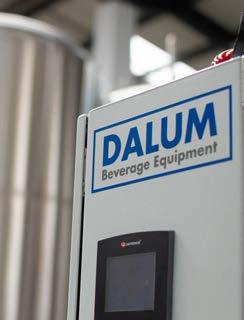
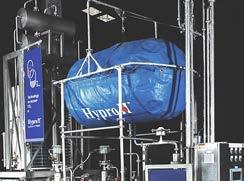
The Dalum CO2 recovery plants are “big brewery” technology scaled down, designed, and priced for craft breweries. The plant promotes a circular utilization of the brewery’s CO2 by recovering the CO2 from fermentation. It is collected, purified, liquefied, stored, and ready to be used in all steps of beer production. As a complete CO2 recovery system, the plant reduces the brewery’s CO2 emission and gives a reliable and cost-efficient supply of CO2 – making your brewery more suited for the future. We estimate that for every kg of CO2 recovered, 2 are saved from not sourcing.
The plants are available in 4 different sizes covering capacities from 1,000 hL/y to 100,000 hL/y.
At Dalum Beverage Equipment, they are proud to meet the growing demand and need for craft breweries to access affordable and advanced technology. Dalum Beverage Equipment manufactures advanced and affordable, ressource and cost-saving process equipment for craft breweries and beverage manufactures to become self sufficient with CO2, and become more sustainable. At Dalum they strongly believe in customer insight and innovation as means to achieve this mission.
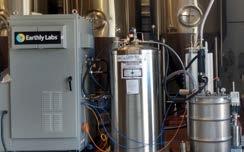
Earthly Labs technology creates a circular economy affordably capturing, purifying and liquefying carbon dioxide for re-use. Improving sustainability, reducing costs and mitigating against supply chain issues. Small-scale carbon capture technology designed to serve the needs of emission sources such as craft breweries, commercial greenhouses and other small to medium sized industries. They provide the full solution—hardware, software, installation, engineering, and real-time remote maintenance services. CiCi CO2 capture solution allows customers to affordably capture CO2. The CiCi solution includes hardware, software and services. CiCi’s patented purification technology transforms a mixed gas waste stream to value, while reducing greenhouse gas emissions.
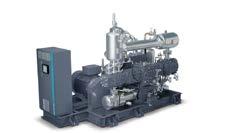
Atlas Copco offers compressed air systems, onsite nitrogen generators, process cooling, process filtration and CO₂ recovery solutions, all designed to minimise environmental impact while maintaining high-quality standards. Supported by an international service network, breweries of all sizes can benefit from local expertise and rapid assistance wherever they operate.
Atlas Copco can advise customers on how to meet the correct ISO 8573-1 air quality standard for their particular application, which helps ensure that critical processes, such as bottling or packaging, remain uncontaminated. The company’s approach to innovation emphasises energy efficiency and resource savings, reflecting growing industry demand for sustainable production methods. By combining technical expertise with responsive service, Atlas Copco aims to support customers worldwide in achieving safe, reliable, and efficient operations across a broad spectrum of industries.
Pneumatech has provided industry-leading compressed air treatment and gas generation solutions to customers across the globe. They pioneered external heat regenerative dryers, introduced variable speed technology on refrigerant dryers and pushed the energy efficiency of nitrogen and oxygen generators to the highest level. Their innovative products and solutions provide clean, dry air and gas to the brewing industry as well as general industries such as automotive, textile, power generation, oil & gas, food & beverage, and electronics. With Pneumatech on-site nitrogen generation, you can generate brewer-quality nitrogen, at a fraction of the cost of delivered CO2. This allows you to take control of your gas supply, reduce your carbon footprint all while saving thousands of pounds,
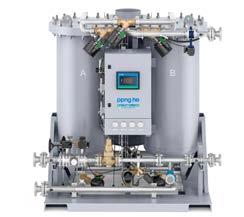
Introducing on-site nitrogen generation from Direct Air can not only provide your organisation with energy and cost savings, but also have a positive impact on logistics and health & safety for your site. The cost of generating your own nitrogen can be up to 80% less when compared to bottled nitrogen or bulk liquid nitrogen storage.
Direct Air work with leading manufacturers to be able to offer bespoke nitrogen generation solutions. They’re proud to be able to can offer the complete nitrogen package including compressors, pipework, nitrogen generators and essential downstream equipment. The process will be managed in-house at Direct Air from the initial contact to ongoing maintenance.
Nitrogen generators continuously produce high purity nitrogen from compressed air and the installation is simple: pipe in compressed air and pipe out nitrogen. Just connect a compressed air line to the inlet of the nitrogen generator package, connect the outlet to your nitrogen line and the unit is ready for trouble free operation.
A continuous supply of consistent purity is then available minutes after start-up, and it can expand in line with your business needs – a complete future proof solution.


CompAir offers an ideal solution with a comprehensive range of cost effective nitrogen generator systems from compressed air, that enable users to produce their total demand for nitrogen gas on their premises and under their control.
Compared to traditional methods of supply, on-site nitrogen generator is exceptionally cost-efficient with a short payback time on investment - in many cases less than twelve months.
Nitrogen is used for a wide range of industrial applications including atmosphere packaging for perishable food products. It is also used in preventing fire and explosions in chemical plants. Using high quality compressed air to supply the generators, ensures long and trouble-free service and guarantees optimum performance.
CompAir has a comprehensive range of systems that include everything needed to set up an on-site nitrogen generation system. CompAir air compressors and pre-treatment packages include adsorption dryers and coalescing filters to guarantee the highest quality air supply for the generators. The gas can be produced from your existing system with a minimum of additional floor space. Typical gas supply methods include high pressure cylinders, liquid mini tanks or bulk storage vessels.

CPA Engineered Solutions’ gas generators produce high purity nitrogen from compressed air. Nitrogen can be produced at low dewpoints from nearly any compressed air supply. Their range is designed to continually transform standard compressed air into Nitrogen at safe, regulated pressures by utilising pressure swing adsorption (PSA) technology. The company’s nitrogen gas generators are suitable for use in various applications, serving many of today’s major industrial markets. Additionally, and as a long-term strategy, the lower cost of generated Nitrogen compared to CO2 cylinders and bulk liquid will help reduce your company’s expenditure and offer significant savings. Less CO2 used in the process also means less CO2 released into the atmosphere, reducing greenhouse gas emissions.
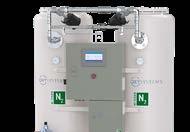
Oxysystems Ltd is a privately-owned company established in 2012 in the UK, with a branch in the EU. Their founding mission was driven by a desire to revolutionize the gas generator industry through unparalleled expertise and passion. Initially serving as distributors and partners for prominent brands, they embarked on a journey of technological advancement, culminating in the development of their own cutting-edge products over the course of several years. Throughout this evolution, they actively engaged in diverse projects worldwide.Oxysystems offers distinctive Oxygen & nitrogen generators, high pressure compressors, and comprehensive PSA systems. Moreover, they are revolutionizing the generator industry with eco-friendly and selfsufficient solutions. Furthermore, their commitment to technical innovation and unparalleled expertise allows them to provide PSA technology to diverse sectors and industries.
Nitrogen Generators are increasingly becoming more popular as nitrogen is used in many commercial and industrial applications to improve the quality of a product or process or as a safety measure to prevent combustion. Liquid or bottled nitrogen delivery and storage can be expensive, unreliable and a safety concern. Nitrogen generators allow users to produce nitrogen in-house simply and inexpensively using an existing compressed air system. ACS recognises the importance of having a safe, reliable and costeffective supply of high-purity nitrogen. ACS has in its range the ALMiG (Mikropor) MNG Series PSA Nitrogen Generators that can meet the increasing demand for high quality the complete packaged solutions and its energy saving controls.


Fit to Fill
UHP Keg Cleaning
Ullage
Keg Degassing
Spear Extraction & Visual/Oral Inspection
External Keg Washing and Label Removal
Micro Analysis
Chimb Correction
Neck Correction
Spear Insertion & Torquing
Keg Gassing-Up/Leak Test Tank
Keg Discharge & Storage
Technical & EHS Compliance
Data Capturing



WHETHER IT’S A LOCAL BREWERY OR A GLOBAL PRODUCER BOTH SHARE THE SAME GOAL: TO CREATE HIGH-QUALITY, GREAT-TASTING BEER. YET, THEIR SIZE, RESOURCES, AND CHALLENGES SHAPE
HOW THEY ACHIEVE IT. BUT WHAT ARE THE UNIQUE QUALITY CONTROL CHALLENGES THAT ARE BEING FACED BY CRAFT BREWERIES AND LARGE PRODUCERS?
TOM BROWN, MARKETING DIRECTOR AT FLAVORACTIV EXPLAINS MORE.
Small breweries are known for their creativity, local ingredients, and pushing the boundaries — it’s what makes them so exciting for beer lovers.
But brewing on a small scale isn’t without its challenges, especially when it comes to keeping things consistent throughout the brewing process and maintaining quality.
One of the first hurdles many craft breweries face is working with limited resources. Small teams, basic equipment, and the absence of dedicated quality control labs mean that brewers often juggle everything from recipe development to business operations. While this hands-on approach keeps the creativity flowing, it can also make it harder to deliver consistent results with every brew.
Ingredient variability adds another layer of complexity. Local and seasonal ingredients give craft beers their unique character, but they also bring unpredictability. Hop profiles can shift between harvests, and yeast behaviour can vary from batch to batch. For small breweries, even minor ingredient changes can noticeably impact the final flavour, making consistency an ongoing challenge.
Mistakes in small batch brewing carry amplified consequences. A single error during brewing or fermentation can result in significant off-flavours or spoilage. For breweries producing limited volumes, the financial impact of a lost batch can be devastating, reinforcing the need for precision and control.
In contrast, large brewers focus on delivering consistency across massive production volumes — often exporting beer worldwide while maintaining an identical flavour profile. Large breweries minimise variability by sourcing
standardised ingredients in bulk and using automated systems to tightly control brewing processes. Automation can help to reduce human error and ensures that flavour profiles remain consistent across multiple sites.
Automated monitoring tracks critical variables like temperature, pH, and pressure throughout production. Sensory analysis also plays a central role: trained tasting panels assess products at multiple stages to catch any deviations early.
Shipping beer across continents introduces its own challenges.
Large producers stabilise beer using pasteurization or filtration techniques, ensuring it remains fresh over long periods — albeit sometimes at the expense of flavour complexity. Nonetheless, their refined logistics systems ensure that consumers experience consistent quality worldwide.
Despite their differences, craft and large-scale brewers have lessons to share. While creativity is essential, small breweries could benefit from more structured quality control methods. Tracking key brewing metrics, monitoring ingredient variability, and adopting simple technologies — such as fermentation monitoring — can reduce errors without compromising innovation.
Large producers, often known for consistency, can learn from craft breweries’ dynamic approach to brewing beer. Limited-edition and seasonal styles offer a chance to experiment and connect with ever shifting consumer tastes, bringing a little more passion into large-scale brewing.
Regardless of size, the need for tight sensory practices, flavour consistency, and freshness is universal. Quality control measures are essential for delivering the best possible beer to thirsty customers.
Are you getting the most out of your data? The answer is that you’re probably not, as most of it is collected manually and notes taken on brew sheets, maybe to be logged into an ERP. But today, data is arguably one of the most important ingredients for breweries from the UK to the US, and beyond.
Why? Because if you’re not using data to guide your brewery, you’re likely losing valuable time in production, travelling into the brewery on weekends to take samples, struggling to see batch-tobatch consistency during production and spend time looking through paper logs if something is off (only to find that the sheet in question is missing).
We are founded on the idea that to improve over time, you need to track both process and performance. You need to know where you’re at right now, and where you need to get to. And that’s how we’re helping over 300 breweries all over the world.
Our Plaato Pro sensors provide real-time fermentation data and insights that allow brewers to identify ideal times for key parts of their brewing process.
Whether that’s an alert to notify when to dry hop or to say that you’ve reached the best time to put your beer into diacetyl rest. Simply put: the Plaato Pro enables you to take the right action at the right time. More than once, our customers have saved the entire technology investment in a matter of months, by
alerting the brewing team of a glycol system failure, saving batches that would have otherwise been lost.
And while sensor and communication technology is the first step, it needs to be backed up by cloud technology built for breweries. Want to see how your tanks are doing?
With us, you can simply pull out your phone at home, and have a full overview of your brewing process at a glance. These solutions are not a vision for the future, they’re already here – and the brewing industry leaders have been using them for years, but in a way that’s not as tailored to their needs.
Now, with Plaato, our more breweryfocussed solutions help remove the stress of running a brewery, by allowing you to always stay on top of what’s happening in your brewery, even when you’re not there.
Users of our technology and platform have used it both for production optimisation (more for less), but also to change the way they work. In the UK for instance, we’ve seen Fell Brewery significantly reduce their carbon footprint by eliminating sampling waste. And, in the US, breweries like Beer Tree Brew have been able to increase their production by over 20% using the same equipment, but using the data to finetune their operation.
“There’s a big carbon saving to be had from reduced sampling, but the biggest saving, in our opinion, is in the form of reduced ingredients,” explains Tim Bloomer, the founder of Fell Brewery, an independent brewery from Cumbria.
By using the fermentation data in a smarter way, breweries are seeing consistent savings of 12 to 24 hours per batch, simply by pinpointing the endof-fermentation with greater accuracy. What’s more, our customers are winning awards for outstanding beers, thanks to their investments in production quality and consistency.
And while better data is just one of the factors, we’re proud to partner with outstanding craft brewers and to see them successfully brew their best beer, every single time.
“Plaato alerted me fermentation started to drop off, I was way low on alcohol. So right then, I added more Belgian candy sugar.... I kicked another fermentation off of it to drive the alcohol up a little bit and it really worked. I mean, we won a gold medal for it,” says Jeff Claxton, the owner and brewmaster at Apogee Brewing.
So we don’t just see ourselves as tech makers, we’re partners, beer-lovers and engineers who want to help breweries (of all sizes) succeed and thrive.
The brewing industry is changing, along with every other industry out there, and continues to be a competitive climate where you have to make great beer: consistently, but also operate a successful and profitable business.
However, we truly believe that when you measure, you can succeed. And we’re the ones who love to measure most! (We even named our company after a measurement unit: degrees Plato or °P.) Like breweries, we don’t believe in
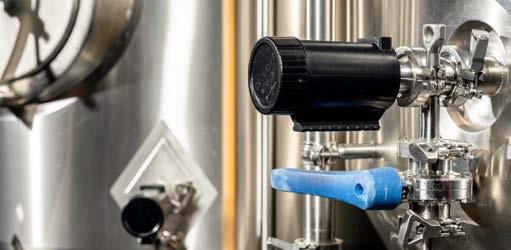
standing still. We’re constantly innovating and listening. Which is why we’ve now launched our industry-changing product called Plaato Edge. This solves even more data collection problems for breweries; it plugs simply into your brewery’s PLC (programmable logic controller) and cloud-connects the equipment across your entire production floor, from your mash tun to packaging –and brings it all together in one platform, adding a level of visibility and control not seen anywhere else.
This means that now, finally, breweries can have all their production data in one place. In short, it means you get the full story of your beer, every batch, from start to finish. Interest in the Plaato Edge has been exceptional, where we’ve had breweries all over the world exploring the potential even in the early stage of development (including a few of the top UK breweries, such as Queer Brewing).
What does all this mean? Well, to us, it’s the beginning of the ‘unification’ of a brewery’s data. No longer will it be siloed, or left in paper binders in a dusty cabinet. Now it will be honoured and interpreted. Data has no value until it is analysed, understood – and turned into information. And this information can lead to improvements, actions and automation.
That is when it transforms your brewing and your beer. Quality, consistency, throughput, profitability – whatever your goal is, let’s start with the data: make a plan and track your improvements. Step by step. Continuous improvement is what gets us excited.
We are proud to be helping breweries of all sizes operate like the best in the industry; enabling them to reach maturity in their manufacturing processes, akin to what we see happening in every other industry: from cars to pharmaceuticals to computers. For inspiration: all we have to do is to look around us. “For a brewery that always strives to be more efficient with both time and ingredients, this is a huge improvement. The Plaato devices are the one gadget that I would wholeheartedly say is worth every penny, and they really do stand up to the claims that they make,” explains Jason Williams, head brewer at Burning Barrel Brewing.
So how should a brewery start on its measuring journey? From our experience, managing a complex production system without data is extremely hard and leaves too much up to chance. Instead, a brewery needs to pick one (or a few) objectives to improve upon. Based on what you consider the most valuable and important improvements. (In fact, why not have a think now yourself, and see what they are for you – even writing them down
can help.) Then we suggest a system called Plan-Do-Check-Act or PDCA. It’s an iterative design and management method used in business for the control and continual improvement of processes and productions.
Step one is to define the baseline: How good are you today? Find a measurable way to define this (find the data!). Step two is set a target: How much better do you aim to be? How will you measure these improvements? Step three is plan. Map out the initiatives you believe will have the biggest impact on these targets/objectives. For example, if increased production is your objective, then how do you most easily achieve this? Faster tank turnaround is one example that we’ve seen that has allowed customers to increase productions by over 20% whilst using the same equipment.
The next step is to do. Implement the improvements and then measure the changes in productivity over the course of some weeks. Step five is check. Assess the effectiveness of the change and finally act. Consider what further changes should be made to get the desired results. Then the cycle of continuous improvement can begin, over and over again. And that’s the fun part: each week, each month you can see yourself, your team, and your brewery improve. And so will your customers.
NOT EVERY PROCESS SUITS A HEAT PUMP BUT FOR THE RIGHT APPLICATIONS, THE SAVINGS CAN BE SUBSTANTIAL. IF THERE’S ONE THING EVERY BREWER KNOWS, IT’S THAT YOU CAN’T MAKE GOOD BEER WITHOUT HEAT. IT’S EVERYWHERE IN THE PROCESS—MASHING, PASTEURISING, CLEANING, KEGGING. BUT AS THE INDUSTRY GETS MORE SERIOUS ABOUT CUTTING CARBON, THE WAY WE GENERATE AND USE THAT HEAT IS COMING UNDER CLOSER SCRUTINY. MIKE BANNERMAN, SUSTAINABILITY CONSULTANT AT NIRAS EXPLAINS MORE.
Not every process suits a heat pump—but for the right applications, the savings can be substantial.
If there’s one thing every brewer knows, it’s that you can’t make good beer without heat. It’s everywhere in the process—mashing, pasteurising, cleaning, kegging. But as the industry gets more serious about cutting carbon, the way we generate and use that heat is coming under closer scrutiny.
That’s where heat pumps start to get interesting. They’re not a new technology by any stretch, but they’ve come a long way—and they’re now offering some very practical opportunities for breweries looking to decarbonise.
“I’ve had a lot of conversations with brewers who are keen to implement heat pumps, but aren’t sure exactly where to begin. Heat pumps have huge potential to decarbonise in a cost effective way, but they need to be matched to the right processes,” says Mike Bannerman, sustainability consultant at NIRAS. And it’s not just brewers asking these questions. Across the food and drink sector, are facing similar challenges. Processes that rely on steady, lower-grade heat are common across the board, and that’s where heat pumps can really deliver.
So, what’s the pitch? At their most basic, heat pumps do something quite simple: they capture waste heat and “upgrade” it to a higher temperature so it can be reused elsewhere in the system. That means less reliance on gas boilers, and fewer emissions from your heating processes overall.
Heat pumps typically produce around three units of heat for every one unit of electricity used—far more efficient than a gas boiler, which usually needs 1.25 kW of gas to deliver just 1 kW of heat, or an electric boiler, which is strictly one-to-one. And because grid electricity in the UK is rapidly decarbonising, that efficiency translates into a significant carbon saving too.
In fact, the Food and Drink Federation has estimated that the food and drink sector could cut its emissions from heat by as much as 64% by 2050 using technologies like this. That’s a big number—but not an unrealistic one, provided we apply the tech where it fits best. Where are heat pumps most effective? Most brewers don’t think of fermentation as a source of energy, but it gives off a fair bit of waste heat. While it’s not perfectly consistent, it’s surprisingly steady—and that makes it a good candidate for feeding into a heat pump. “Fermentation is actually a great source
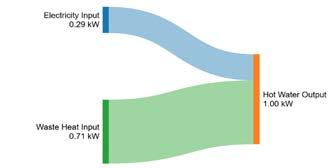
of low-grade heat,” Bannerman explains.
“It’s not high temperature, but it’s stable, and usually linked to a chiller plant. If you can utilise the waste heat from the chillers, you’ve got a ready-made input. From there, one of the strongest use cases is in the packaging hall. Tunnel pasteurisation for example tends to operate at 60-70 degC with generally steady, continuous heat demand—pretty much ideal conditions for a heat pump. Keg washing is another good match— again, you’re dealing with hot water rather than steam, and a predictable load once things are up and running.
“Packaging areas are ideal. The lower temperatures mean there is limited demand for steam, you’ve got consistency, and you’ve got demand. It just lines up nicely,” says Mike. That same logic applies across many food processing sites, too. If you’re running a bottling or canning line, operating thermal processing, or pasteurising product, chances are you’ve got heat demands that fall well within a heat pump’s comfort zone.
On the flip side, the brewhouse is trickier. The loads are higher, more intermittent, and often scattered across different users. Steam is still preferred for these processes, and heat pumps just aren’t quite there yet for those kinds of high, fast demands.
“That doesn’t mean there’s no role in the brewhouse,” Bannerman adds. “There’s definitely potential for things like preheating water, which can take pressure off your boilers. But a fully centralised heat pump system? That’s a harder sell.”
We recently worked on a design project for a large UK brewery looking into exactly this. The site was considering a specific sized heat pump system to help decarbonise its operations. We looked at everything—from energy balances and electrical capacity to infrastructure layout and cost modelling. The projected outcomes included a 40% decrease in Scope 1 emissions and a 33% improvement when it came to heatingrelated cost efficiency. “The numbers

speak for themselves,” Bannerman says. “It’s not just an environmental win—it’s operational savings, too. And that’s what gets people really interested.”
And this isn’t just something for the big players. A 2.5 MW system, for instance, could save around £280,000 a year and reduce CO₂ emissions by 2,600 tonnes annually. That’s the equivalent of taking more than 450 cars off the road—or sending them all the way around the world and back again. Food and drink manufacturers of all sizes can tap into these kinds of efficiencies—especially in areas with stable, repeatable heat demands.
Some planning required—but well worth it. Of course, installing a heat pump system isn’t done instantly. You need to consider how heat and cooling demands line up, whether your electrical infrastructure can handle the load, and how best to distribute the recovered heat. It takes some upfront planning, especially if you’re looking at larger systems that might require a grid upgrade.
“One of the biggest concerns is often around electrical capacity, especially for larger systems,” says Bannerman. “But it’s worth remembering that heat pumps typically deliver around three units of heat for every one unit of electricity. Compare that to electric boilers, which are one-to-one, and suddenly the demand doesn’t look so steep. Yes, you’ll need to plan carefully—but in many
Heat pumps have the lowest emissions per kW compared to both natural gas and electric boilers.
cases, heat pumps actually put less strain on the system than the alternatives.” That’s why a phased approach tends to work best. Start with the low-hanging fruit—packaging, kegging, pasteurisation. Learn what works, then build out from there. Are heat pumps the answer to every sustainability challenge in brewing? No, of course not. But they’re one of the more accessible, lower-risk ways to start moving the dial. They don’t require a fundamental change in how you brew, they don’t compromise quality, and they can often work alongside your existing systems.
“It’s not about chasing perfection,” Bannerman says. “It’s about progress. And heat pumps are one of the most readily available, pragmatic ways to start.”
The key is understanding where they make sense—and acting on that insight. Because as energy prices rise and regulations tighten, the producers who’ve taken the time to get ahead of the curve will be in a far stronger position than those playing catch-up.
Sustainability doesn’t have to mean reinventing your entire operation. It means making considered improvements based on where you are now. Heat pumps might not be the flashiest bit of kit—but they’re a smart place to begin.
A PASSION THAT TURNED PROFESSION. THE STORY OF MIKE CLAYTON-JONES, CO-FOUNDER OF DOUBLEBARRELLED, WILL RESONATE WITH MANY. HERE HE SHARES A WEALTH OF HIS FORMATIVE EXPERIENCES THAT HAVE HELPED CRAFT THE MUCHLOVED READING-BASED BREWERY HE STARTED WITH WIFE LUCI.
If I look back over my history with beer there are a few stand out moments that if I had spotted the signs earlier, I might have done things differently. Likely though, I still would have ended up in the same or similar place. My first interaction with non-macro lager was in my college bar at university. I’d got a job working behind there in my first year, as a way of getting involved in the social scene.
Alongside the predictable lines for the early 2000’s there was a permanent cask line of Deuchars IPA on tap. Turns out it had just won BIIA World Champion Cask Ale - I hadn’t paid it much notice until one New Years Day, the landlord knowing the bar was about to be shut for three weeks. They that insisted the four of us were going to drink as much of the remaining tapped cask as possible.
With heavy hangovers to drink through, we gave it a rock solid go, but in the process my perspective changed a little and the idea of there being alternative beer styles to the mass produced lagers had taken root quickly. It was some years later, and having collected a few hobbies, most of them revolving around wanting to know how things worked, that meant making beer was going to be a part of my life.
I found myself in a Wilkinson’s, with no memory of what I was looking for, but stumbling across an aisle dedicated to making beer at home.
I remembered being on a work conference earlier that same year, where a colleague had mentioned he and his dad made beer together all the time and how rewarding it was for the two of them to spend time bonding over, not to mention that they then had access to as much cheap beer as they could ever want.
Wanting to understand how beer was made, and subsequently getting my hands on a cheaper source of it went hand in hand, and my mind went back to those pints of Deuchars at New Year. Remembering there was something in the alternative, that there were different flavour profiles, and seeing a wall of oversized cans of malt extract bases for all manner of beer styles.
I picked one more or less at random and grabbed a “complete Coopers home brew kit” – a plastic bucket, a spoon, a hydrometer and 40 plastic screw top bottles; and took them home. Followed the kit to the letter and waited the two weeks with this bucket going through all kinds of madness in my airing cupboard.
I had very little idea what was going on inside it, but the contents smelled fruity, and I was beyond excited.
Once bottled, conditioned and allegedly carbonated, I opened the first one up with a mixture of anxious excitement and hesitation. Poured out my first home brewed beer… gave it a sniff and was pleasantly surprised to notice that it wasn’t terrible. Don’t get me wrong, it certainly wasn’t a hit, but with 40 bottles of drinkable beer I had made at home – I didn’t realise at the time quite how firmly down the rabbit hole I had already become.
The next steps can more or less sum up the way I work in general. I had gotten a tiny taste of this hobby, and of a very mediocre beer, but immediately wanted to jump in at the deep end and go from the one malt extract kit I had completed to date, to buying a full all grain home brew set up. I knew I could make something better than the extract kit I had started with, and I was now on a mission to do exactly that. It was around this time that I had started drinking “craft beer” with my mates, and through very fortunate circumstances
I didn’t realise at the time quite how firmly down the rabbit hole I had already become,” Mike ClaytonJones, Double-Barrelled

came to count Joel Mellor of The Hop Locker fame, as a good friend. With access to the latest beers in a young and growing UK craft beer scene, I would spend as much time at the South Bank Food Market as I could.
Each visit I’d be left trying to work out how to get anywhere close to some of the heavy hitters of the time – Mrs Brown by Siren, or Cannonball by Magic Rock, Jack Hammer from Brewdog and Black Betty from Beavertown!
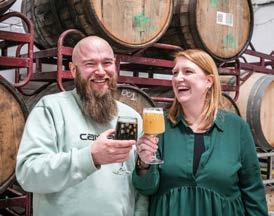
Mike and Luci Clayton-Jones Double-Barrelled Brewery
Every time I tried something new it was fuelling my desire to want to know how to make it. I’d write recipes that pushed complexity of dark malts through the roof, or add in obscene amounts of crystal malt derivatives way beyond suggested levels to see what it did to the end result – in short, very sweet and low strength… could do better! I had picked up a copy of John Palmers book How To Brew, and was making my may through it. Whilst also just finding out what did and didn’t work. Fast forward slightly, and my partner Luci and I were planning our wedding. Alongside putting together a beer list for our guests, as a number of us were now fully fledged “craft beer enthusiasts” to be polite.
We were also working on a home brewed beer as a wedding favour. This was the first time the name Double-Barrelled was uttered, in jest really, as a nod to Luci taking my already double-barrelled surname.
So, the beer got brewed, bottled, labelled, and given an identity. The process of working on that together had left a lingering idea in both of us, and it was something we kept talking about whilst on honeymoon. So much so, that the day after we got back, we registered the name with Companies House, just in case.
It’s worth mentioning that at this point that Luci and I had been working in corporate careers, (food & drink marketing, and supply chain management/consultancy respectively), with neither of us particularly overjoyed at staring down the barrel of another 30+ years of doing that.
Some circumstances happened in our personal lives, that left some rather gaping holes and a sense of life being very much too short to be doing something you don’t care much about. With that and a mantra of only regretting the things you don’t
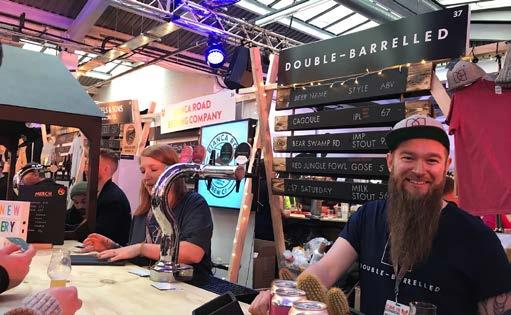
do, we started seriously considering the prospect of a move to the beer industry. The glaringly obvious lack of experience and knowledge of the sector, commercial brewing practices and running any form of hospitality led business was a priority to deal with.
Our approach couldn’t be described as the most traditional, but armed with our “life is short” mentality, and knowing that if we did open a business together it would be all encompassing at least for the early years meant we took the decision to do some extensive research. This research took the form of a trip away… a very long trip away!
What conceptually began as an extended road trip across the US exploring a craft beer scene that was more mature than the UK at that time, quickly morphed and grew as we looked further into the nuances of small batch beer and alcohol production around the world.
A European leg was added to understand much more about alcohol production practices steeped in history, visiting multigeneration wine producers as well as some of the oldest breweries in the world. That was followed by a South and Central American extension, for more wine knowledge, as well as Tequila and Mezcal production.
We also learnt how ancient civilisations like the Mayans made Chicha – a fermented corn drink. We spent time in Australia and New Zealand, with more small wine producers alongside hop farms and the breweries that are fortunate to reside on their doorsteps.
Centuries old methods for production of Sake whilst visiting Japan, as well as other pockets of the Pacific. Visiting one of the most remote inhabited islands in the world; Rapa Nui
(Easter Island) where even here craft brewing is alive and well. On top of having already spent and continuing to see what was happening back home in the UK, a constantly evolving landscape – for example when we left for our trip, Verdant and Deya were in their infancies – look at what they have achieved now! Along the way, we spent hundreds of hours in a myriad of breweries, tasting rooms, bars, venues and bottle shops. All of which helped to shape, and really crystalise what Double-Barrelled would become.
It was early on in the trip that what I had suspected would involve brewing at some level, was solidified – I just couldn’t shake the idea of making the best beer possible, packaging it, and putting it out for the world to try.
Hearing the start-up stories from so many small alcohol producers and the passion they all poured into what they made really struck a chord. We sought advice along the way
We spent hundreds of hours in a myriad of breweries, tasting rooms, bars, venues and bottle shops,” Mike ClaytonJones, Double-Barrelled
– How big should we go? Where would you build if you were starting from scratch? What would you do differently now, knowing what you went through in the set up? What were the major successes? How did you overcome the challenges? Everyone that we visited was prepared to offer advice, support, answer questions, help and above all offer us their incredible hospitality.
Seeing how much this industry supported people who were trying to get involved in it, let alone what could happen with deeply forged relationships was really eye opening. The responses we got cemented the ideas we were forging of becoming part of this industry. We couldn’t soak up more information if we’d tried.
We’d spent a total of 11 months collecting information, meeting people, and really refining what we wanted DoubleBarrelled to be. Living life out of a backpack was exciting, always on our way to see what was happening elsewhere – we moved through 29 countries along the way, with the longest we stayed in any one city just five nights.
Whilst travelling my attention had started to turn towards the knowledge and skills gap of how to actually go about making high quality beer.
I was reading books on the go – still making my way through How to Brew by John Palmer, Wood & Beer by Dick Cantwell & Peter Bouckert, the Brewing Element Series from authors such as John Palmer (again), Colin Kaminski, Jamal Zainasheff, Chris White and John Mallett.
I picked up e-books with information on hop varietals, making notes about pairings I wanted to try myself as well as looking out for those combinations in the taprooms and bottle shops we were visiting.
Access to the information was fantastic, but I was desperate to put some of this knowledge and learning into practice. Literally overflowing with ideas, and not wanting to waste any time at all, we purchased our first commercial brewhouse and FVs – a 100l two vessel system and a pair of conical jacketed FVs from Elite Stainless.
We filled in the relevant forms with HMRC, applying to turn our garage into a premises licenced to produce alcohol, and signed up to AWRS. After a couple of batches to figure out the kit, get to grips with the concepts of everything I had read, this was it. Time to make some beer.
During the journey, we had decided if we were going to do this, we wanted to home in to a specific point of difference. The early aims of Double-Barrelled were focussed on making huge Stouts (the bigger the better) and Fruited Kettle Sours. Certainly these were the beers we were enjoying the most when we were out researching, particularly in the US. The UK beer scene was lacking someone who was spending their time predominantly on these styles, so we felt it was an opportunity worth exploring.
Meanwhile, Luci was spending her time looking at how we could bring Double-Barrelled into the world – out of the garage and in front of the people.
At the time (September/October 2017) the opportunities to get in front of a lot of people in a short space of time were limited, unless you already had a solid contact list/experience of working within the beer industry. We made the call to sign up to Craft Beer Rising and launch Double-Barrelled in February 2018, to as many people as possible.
They suggested we needed to bring twelve 30l kegs to pour across the three days. I did some sums, and worked out I didn’t have a tremendous amount of time to make mistakes, or perfect those early recipes.
We made the decision to do things differently, coming to market without brewing a pale ale or an IPA.
Our launch at Craft Beer Rising saw us bring an Imperial Stout, an India Pale Lager, a Raspberry and Beetroot Gose, and a Milk Stout.
For Double-Barrelled CBR was a way to test whether we had what it took to take things further, and really plunge into brewing on a commercial scale.
Having effectively home brewed everything, admittedly on a more sophisticated kit than most homebrewers were using at the time, it was an incredible feeling to watch people take notice of our branding, read the list and decide to try something. Even better yet, when someone took their first sip, looked up and just smiled at us.
The reception of all of those beers across those three days was mind blowing – we had people coming over saying they’d been made to come and try them, we had pro brewers coming over and saying the nicest possible things about beer I had literally sat in my garage and made.
The test of CBR had definitely given us the confidence to take things further. The confidence to make a huge leap from those 100l batches in my garage, and go straight into 24hL on our full size kit also (justified by a lot of the discussions of those who’d done this journey before).
Summer of 2018 saw us move into the building we still call home. And very quickly we realised we needed to brew more than just imperial stouts and sours. A small core range began and has been growing ever since, alongside an ever rotating list of special beer releases and one-offs.
And overleaf you will fin is the original recipe for a beer called Seven Dollar Saturday. It was our first milk stout and one that formed the basis of several more we have produced over the years since starting out.
Like the brewing visionaries Anton Dreher and Gabriel Sedlmayr, we at AEB spend a lot of time looking through a microscope searching for the perfect yeast strain to make your beer the best.
FERMOLAGER Munich Heritage yeast is the ideal choice for brewing the world’s greatest Lager styles.
A hugely versatile bottom-fermenting yeast intended for the production of a wide range of European lager style beers, from the highly traditional Märzen styles of Munich and the more deeply coloured, Dunkles and Bocks and the drier brews of Vienna to more contemporary styles like Bohemian Pilsner and Bavarian Helles
Apparent attenuation: 78-80%
Fermentation Temperature: 10-14°C / 50-57°F
Flocculation: Medium-High
Alcohol tolerance: 9-10% ABV
Aroma and Flavour: This low-diacetyl producing strain, produces low levels of esters, sulphur compounds and higher alcohols, leading to beers with a clean mouthfeel showing delicate noble hop flavours over an underlying malt structure.


www.aeb-group.com For 10% Discount in our webshop, enter Journal10 athttps://shop.hopsteiner.com/

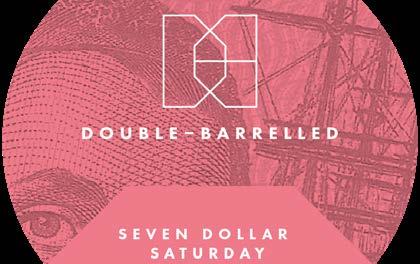
Here is the original recipe for Seven Dollar Saturday, our first milk stout and one that formed the basis of several more we have produced over the years. I wanted to put a recipe out that reflected back on the early days of Double-Barrelled, and with fondness I chose Seven Dollar Saturday – the milk stout that we took to CBR, and subsequently got rebrewed in the very early days of our step up to commercial sized batches. The name comes from a story we picked up talking to Jason and Craig, two of the founders of Big Shed Brewing in Adelaide, South Australia. They had done similar things, stepping up from home brewing together, to opening a small brewery with their partners and eventually scaling up to some seriously impressive proportions.
The story goes that in their early days of selling beer to the public, someone came in one Saturday and bought just one pint for $7AUD, and that was their take for the day. A few years later as they’d grown and evolved, if one of them was having a bad day for whatever reason, they held on to the reminder that it might be hard but it’s not as hard as that Seven Dollar Saturday. So we borrowed the memory and used it to keep us grounded when times were and continue to be hard. In recent times the style has fallen out of favour, but it has always had a soft spot in my heart. Lactose is really easy to overdo, so is intentionally understated on this recipe to avoid
the gritty-ness that it can bring when used too heavily. I have omitted any water additions, as this will depend very much on what you start with. For reference, we are based in Reading with some of the hardest water I have experienceD –as it happens great for making dark beer, so we typically don’t do much in the way of water treatment beyond lactic acid to target the right pH.
If you are using water treatment, I would always recommend using component salts and acids over catch all water treatment products, to aid in control and allow you to tweak very specific ratios. For what it’s worth and more broadly speaking if you are wondering what to spend your money on when it comes to homebrewing, I would always recommend starting with good quality, reliable and efficient temperature control for fermentation and work back from there. By all means feel free to tweak the below to suit you becayse the beauty of homebrewing is that you can literally make what you want. My ethos was to change one thing each time you brew the same recipe to see the effect, if you change five things targeting a specific profile in the finished beer, it becomes much more difficult to know which change had what impact and then to take that on to your next recipe.
Happy brewing!
SEVEN DOLLAR SATURDAY
Target OG: 1.062
Target FG: 1.020
Efficiency – 75%
Batch size – 25l
Grist
Extra Pale – 4.8kg - 80%
Chocolate – 0.6kg - 10%
Pale Chocolate – 0.24kg - 4%
Light Crystal – 0.24kg - 4%
Flaked Oats – 0.12kg - 2%
Mash
Target Mash temp – 68C
Liquor:grain ratio – 2.8l/kg
Mash time – 60 minutes
Mash liquor – 16.8l
Sparge liquor – 18.2l (75c)
Collect 28l wort
Boil – 60 minutes
Boil hops
60 minute - Columbus – 20g - 15%AA target IBU – 32
15 minute – Lactose 0.5kg
10 minute – Hallertau Mittelfruh – 6g –
3.75%AA target IBU – 0.8
10 minute – yeast vit – as directed based on product specs
5 minutes – Hallertau Mittelfruh – 12g –
3.75%AA target IBU – 1.9
Fermentation & conditioning
Yeast – S-04 Fermentis/Safale English Ale
Pitch temp – 18C
Free rise – 20C
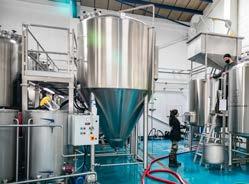
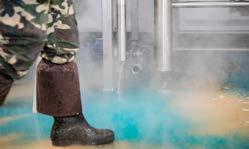
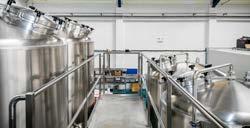
Cold crash to 10C at end of fermentation, if possible transfer off yeast cake and chill to 0C for minimum 7 days.
If you have the ability to force carb in FV before packaging, I feel it gives you far greater control over your finished beer, and with modern homebrew kit being that much more advanced than the simple bucket set ups I started with that may be possible.
That said, use your standard carbonation and packaging method as this is very much equipment and personal preference dependant.
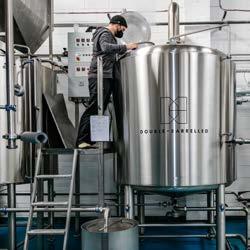
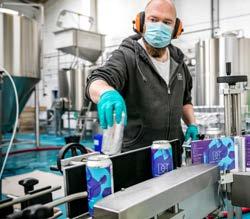

www.enterprisetondelli.co.uk
info@enterprisetondelli.co.uk

www.nchfittings.co.uk sales@nchfittings.co.uk
FLOORING

www.AngliaDecor.co.uk 01245961933

Konvoy is the leading global IoT (Internet of Things) keg tracking & pooling solution. Founded in Australia 2019, and the UK in 2022, Konvoy are revolutionising the beverage industry with edge asset tracking technology and simplifying the pay-per-fill pooled keg rental business model. Konvoy is moving beverages forward by enabling greater efficiency, effectiveness, quality, circularity and sustainability from producer to venue and back again.
www.konvoykegs.com
konvoy@konvoykegs.co.uk 0800 4681468
WILLIS EUROPEAN LTD
WOLVERHAMPTON, UK 01902 798880
INFO@WILLISEUROPEAN.COM
WWW.WILLISEUROPEAN.COM

Gravity Systems was formed to meet the growing demand in the craft beer market for a single source for all brewhouse, fermentation Service generation and distribution www.gravity-systems.co.uk
+44 (0)1733 834264 www.enquiries@gravity-systems.co.uk


WILLIS EUROPEAN LTD
WOLVERHAMPTON, UK 01902 798880
INFO@WILLISEUROPEAN.COM
WWW.WILLISEUROPEAN.COM
Brewing, bottling, canning or kegging. Whether you are an existing brewery or starting your own brand, Hambleton Contract Brew Co. has the perfect contract solution for you. YOUR BEER, OUR EXPERTISE
ben@hambletonbrewery.co.uk 01765 640 108

charlesfaram.com/uk
+44 (0)1905 830 734 sales@charlesfaram.co.uk

PakTech designs and manufactures 100% recycled, recyclable and reusable packaging handles. PakTech is the smart and sustainable packaging solution. www.paktech-opi.com handlesales@paktech-opi.com Phone: +1.541.461.5000


Fermentis is an expert in the art of fermentation. Our active dry yeasts and yeast derivatives cover almost all professional requirements: from safeguarding production to expressing sensory characteristics. Discover our products on www.fermentis.com Contact us at fermentis@lesaffre.com

25 June 2025
BREWERS LECTURES MANCHESTER
Cloudwater Brewery Taproom, Manchester www.brewersjournal.info/lectures
9th July 2025 - 12th July 2025
EALING BEER FESTIVAL
Walpole Park, Ealing www.ebf.camra.org.uk
5 August 2025 - 9 August 2025
GREAT BRITISH BEER FESTIVAL
NEC Birmingham www.greatbritishbeerfestival.co.uk
5 September 2025 - 7 September 2025
BASINGSTOKE BEER FESTIVAL
Basingstoke Sports and Social Club https://hantsnorth.camra.org.uk/
16 September 2025 - 17 September 2025
DUBLIN BEER FESTIVAL
The RDS, Dublin www.dublinbeerfest.ie
24 September 2025 - 27th September 2025
ST ALBANS BEER AND CIDER FESTIVAL
The Alban Arena, St Albans www.stalbansbf.org.uk
30 September 2025 - 1 October 2025
BREWERS CONGRESS 2025
The Big Penny Social, London https://www.brewersjournal.info/congress
4 October 2025
WANSTEAD BEER FESTIVAL
Christchurch Church Hall, Wanstead http://wansteadbeerfestival.co.uk/








